Register
File index
Image
Description in English
Описание на кириллице
1
Fig. A1

Project Announcement
Before the beginning of the presidential elections in the Republic of Belarus in 2020, we could observe the rapid revival and growth of civil society, which is only strengthening day by day. Every day men and women of Belarus are joining their efforts to achieve the desired changes within the framework of peaceful protest. They demand the resignation of Alexander Lukashenko, who has taken over his post through blatantly rigged elections; to return this post to Svetlana Tikhanovskaya, who promised to hold fair elections, release political prisoners and bring to justice all those who took part in rigging, killing, maiming and raping protestants and violated the law. Peaceful protest is getting stronger every day, creating more powerful and complex chains of solidarity and networks of mutual support. The world admires the resilience, creativity, culture and fearlessness of Belarussian protestants.
The project Social Marble: the Rise of Civil Society in Belarus is a personal exhibition of Sergey Shabohin. Within the framework of the project, the artist communicates with selected counter-players from Belarus for several weeks about the phenomenon of the rapid revival of civil solidarity in Belarus during a peaceful protest. As a result of the conversations, a dynamic archive is being created and it is systematically placed on the walls of a uniquely designed structure. The archive is aimed at fixing how exactly Belarusian civil society was born, with key prerequisites and important dates; how protest moods emerged and were transformed; and how everything resulted in an organized peaceful revolution. The archive will include a timeline of the rise and development of protest, as well as a glossary of the new civil society. It will consistently include texts, photographs, terms, quotations, references and dates in the form of printed and glued to the wall documents. The entire process is recorded in real-time by a camera. In parallel, an Instagram account (@social.marble) of the project and a detailed project index are maintained as well.
Social Marble: Dynamic Archive of the Rise of Civil Society in Belarus
Before the beginning of the presidential elections in the Republic of Belarus in 2020, we could observe the rapid revival and growth of civil society, which is only strengthening day by day. Every day men and women of Belarus are joining their efforts to achieve the desired changes within the framework of peaceful protest. They demand the resignation of Alexander Lukashenko, who has taken over his post through blatantly rigged elections; to return this post to Svetlana Tikhanovskaya, who promised to hold fair elections, release political prisoners and bring to justice all those who took part in rigging, killing, maiming and raping protestants and violated the law. Peaceful protest is getting stronger every day, creating more powerful and complex chains of solidarity and networks of mutual support. The world admires the resilience, creativity, culture and fearlessness of Belarussian protestants.
The project Social Marble: the Rise of Civil Society in Belarus is a personal exhibition of Sergey Shabohin. Within the framework of the project, the artist communicates with selected counter-players from Belarus for several weeks about the phenomenon of the rapid revival of civil solidarity in Belarus during a peaceful protest. As a result of the conversations, a dynamic archive is being created and it is systematically placed on the walls of a uniquely designed structure. The archive is aimed at fixing how exactly Belarusian civil society was born, with key prerequisites and important dates; how protest moods emerged and were transformed; and how everything resulted in an organized peaceful revolution. The archive will include a timeline of the rise and development of protest, as well as a glossary of the new civil society. It will consistently include texts, photographs, terms, quotations, references and dates in the form of printed and glued to the wall documents. The entire process is recorded in real-time by a camera. In parallel, an Instagram account (@social.marble) of the project and a detailed project index are maintained as well.
Анонс проекта
Еще до начала президентских выборов в Республике Беларусь 2020 года мы могли наблюдать за стремительным возрождением и ростом гражданского общества, которое с каждым днем только усиливается. Ежедневно беларус_ки объединяются в стремлении достичь желаемых перемен в рамках мирного протеста. Они требуют отставки Александра Лукашенко, который захватил свой пост с помощью проведения откровенно сфальсифицированных выборов; вернуть этот пост Светлане Тихановской, которая пообещала провести досрочные честные выборы, освободить политических заключенных и привлечь к ответственности всех тех, кто принимал участие в фальсификациях, убивал, калечил и насиловал протестант_ок и как-то иначе нарушал законодательство. Каждый день мирный протест крепнет, создавая все более сильные и сложные цепи солидарности и сети взаимоподдержки. Мировое сообщество восхищенно следит за стойкостью, креативностью, культурностью и бесстрашием протестант_ок.
Проект “Социальный мрамор: подъём гражданского общества в Беларуси” представляет собой процессуальную персональную выставку Сергея Шабохина. В рамках проекта в течении нескольких недель художник общается с избранными контрибьюторами из Беларуси о феномене стремительного возрождения гражданской солидарности в Беларуси во время мирного протеста. По результатам бесед создается динамический архив, который методично размещается на стенах специально разработанной конструкции. Архив нацелен на фиксацию того, как именно зарождалось беларуское гражданское общество с ключевыми предпосылками и важнейшими датами, как возникали и трансформировались протестные настроения, и как все вылилось в организованную мирную революцию. Архив будет включать таймлайн возникновения и развития протеста, а также глоссарий нового гражданского общества. В архив последовательно включаются тексты, фотографии, термины, цитаты, ссылки и даты в виде напечатанных и наклеенных на инсталляцию документов. Весь процесс фиксируется камерой в прямом эфире. Параллельно ведется инстаграмм аккаунт проекта и подробный индекс проекта.
Социальный мрамор: динамический архив о подъёме гражданского общества в Беларуси
Еще до начала президентских выборов в Республике Беларусь 2020 года мы могли наблюдать за стремительным возрождением и ростом гражданского общества, которое с каждым днем только усиливается. Ежедневно беларус_ки объединяются в стремлении достичь желаемых перемен в рамках мирного протеста. Они требуют отставки Александра Лукашенко, который захватил свой пост с помощью проведения откровенно сфальсифицированных выборов; вернуть этот пост Светлане Тихановской, которая пообещала провести досрочные честные выборы, освободить политических заключенных и привлечь к ответственности всех тех, кто принимал участие в фальсификациях, убивал, калечил и насиловал протестант_ок и как-то иначе нарушал законодательство. Каждый день мирный протест крепнет, создавая все более сильные и сложные цепи солидарности и сети взаимоподдержки. Мировое сообщество восхищенно следит за стойкостью, креативностью, культурностью и бесстрашием протестант_ок.
Проект “Социальный мрамор: подъём гражданского общества в Беларуси” представляет собой процессуальную персональную выставку Сергея Шабохина. В рамках проекта в течении нескольких недель художник общается с избранными контрибьюторами из Беларуси о феномене стремительного возрождения гражданской солидарности в Беларуси во время мирного протеста. По результатам бесед создается динамический архив, который методично размещается на стенах специально разработанной конструкции. Архив нацелен на фиксацию того, как именно зарождалось беларуское гражданское общество с ключевыми предпосылками и важнейшими датами, как возникали и трансформировались протестные настроения, и как все вылилось в организованную мирную революцию. Архив будет включать таймлайн возникновения и развития протеста, а также глоссарий нового гражданского общества. В архив последовательно включаются тексты, фотографии, термины, цитаты, ссылки и даты в виде напечатанных и наклеенных на инсталляцию документов. Весь процесс фиксируется камерой в прямом эфире. Параллельно ведется инстаграмм аккаунт проекта и подробный индекс проекта.
Fig. B1

Glossary Social Marble #1
About Social Marble
Social Marble is the title of a series of works by Sergey Shabohin based on observations of the practice of cleaning services of the Minsk Metro. The workers of this service are unable to wash away the caustic pigments of graffiti applied on the marble walls of underground tunnels in the metro and began glueing them with a tape depicting the marble texture. This tape is often used to protect kitchen countertops, shop counters and other items — it is a low-cost and affordable "social marble". This symbol has a strong image of the political structure of modern Belarus, where intrusive "capitalistic" pigments of aerosols are so deeply absorbed into "soviet" marble that they cannot be washed away and one can only glue it with a chinese tape.
Real marble in its structure is the result of complex geo- and bio-processes that are similar in their regularity and, at the same time, chaotic nature with social processes. As part of the Social Marble cycle, objects, installations and sculptures are created from cheap, mostly hollow, materials and are glued together with a tape that looks like a marble. Pretending to be marble these objects tell about modern myths of Belarus and historical fairies.
About Social Marble
Social Marble is the title of a series of works by Sergey Shabohin based on observations of the practice of cleaning services of the Minsk Metro. The workers of this service are unable to wash away the caustic pigments of graffiti applied on the marble walls of underground tunnels in the metro and began glueing them with a tape depicting the marble texture. This tape is often used to protect kitchen countertops, shop counters and other items — it is a low-cost and affordable "social marble". This symbol has a strong image of the political structure of modern Belarus, where intrusive "capitalistic" pigments of aerosols are so deeply absorbed into "soviet" marble that they cannot be washed away and one can only glue it with a chinese tape.
Real marble in its structure is the result of complex geo- and bio-processes that are similar in their regularity and, at the same time, chaotic nature with social processes. As part of the Social Marble cycle, objects, installations and sculptures are created from cheap, mostly hollow, materials and are glued together with a tape that looks like a marble. Pretending to be marble these objects tell about modern myths of Belarus and historical fairies.
Глоссарий “Социальный мрамор” #1
О социальном мраморе
“Социальный мрамор” — так называется цикл произведений Сергея Шабохина основанный на наблюдениях за практикой службы уборки минского метрополитена. Не в силах смыть едкие пигменты граффити, нанесенные на мраморные стены подземных переходов в метро, работники этой службы стали заклеивать их пленкой с изображением мраморной текстуры. Такую пленку часто используют для защиты кухонных столешниц, магазинных прилавков и других предметов — это бюджетный и доступный всем “социальный мрамор”. В этом символе есть емкий образ политического устройства современной Беларуси, где въедливые “капиталистические” пигменты аэрозолей так глубоко впитываются в “советский” мрамор, что их нельзя смыть, и остается только заклеивать пленкой китайского производства.
Настоящий мрамор по своей структуре — результат сложных гео- и био-процессов, схожих по своей регулярности и, одновременно, хаотичности с социальными. В рамках цикла “Социальный мрамор” объекты, инсталляции и скульптуры создаются из дешевых, чаще всего полых материалов, и оклеиваются пленкой с мраморным рисунком. Эти объекты притворяются мраморными и рассказывают о современных мифах Беларуси и исторических фэйках.
О социальном мраморе
“Социальный мрамор” — так называется цикл произведений Сергея Шабохина основанный на наблюдениях за практикой службы уборки минского метрополитена. Не в силах смыть едкие пигменты граффити, нанесенные на мраморные стены подземных переходов в метро, работники этой службы стали заклеивать их пленкой с изображением мраморной текстуры. Такую пленку часто используют для защиты кухонных столешниц, магазинных прилавков и других предметов — это бюджетный и доступный всем “социальный мрамор”. В этом символе есть емкий образ политического устройства современной Беларуси, где въедливые “капиталистические” пигменты аэрозолей так глубоко впитываются в “советский” мрамор, что их нельзя смыть, и остается только заклеивать пленкой китайского производства.
Настоящий мрамор по своей структуре — результат сложных гео- и био-процессов, схожих по своей регулярности и, одновременно, хаотичности с социальными. В рамках цикла “Социальный мрамор” объекты, инсталляции и скульптуры создаются из дешевых, чаще всего полых материалов, и оклеиваются пленкой с мраморным рисунком. Эти объекты притворяются мраморными и рассказывают о современных мифах Беларуси и исторических фэйках.
Fig. C1
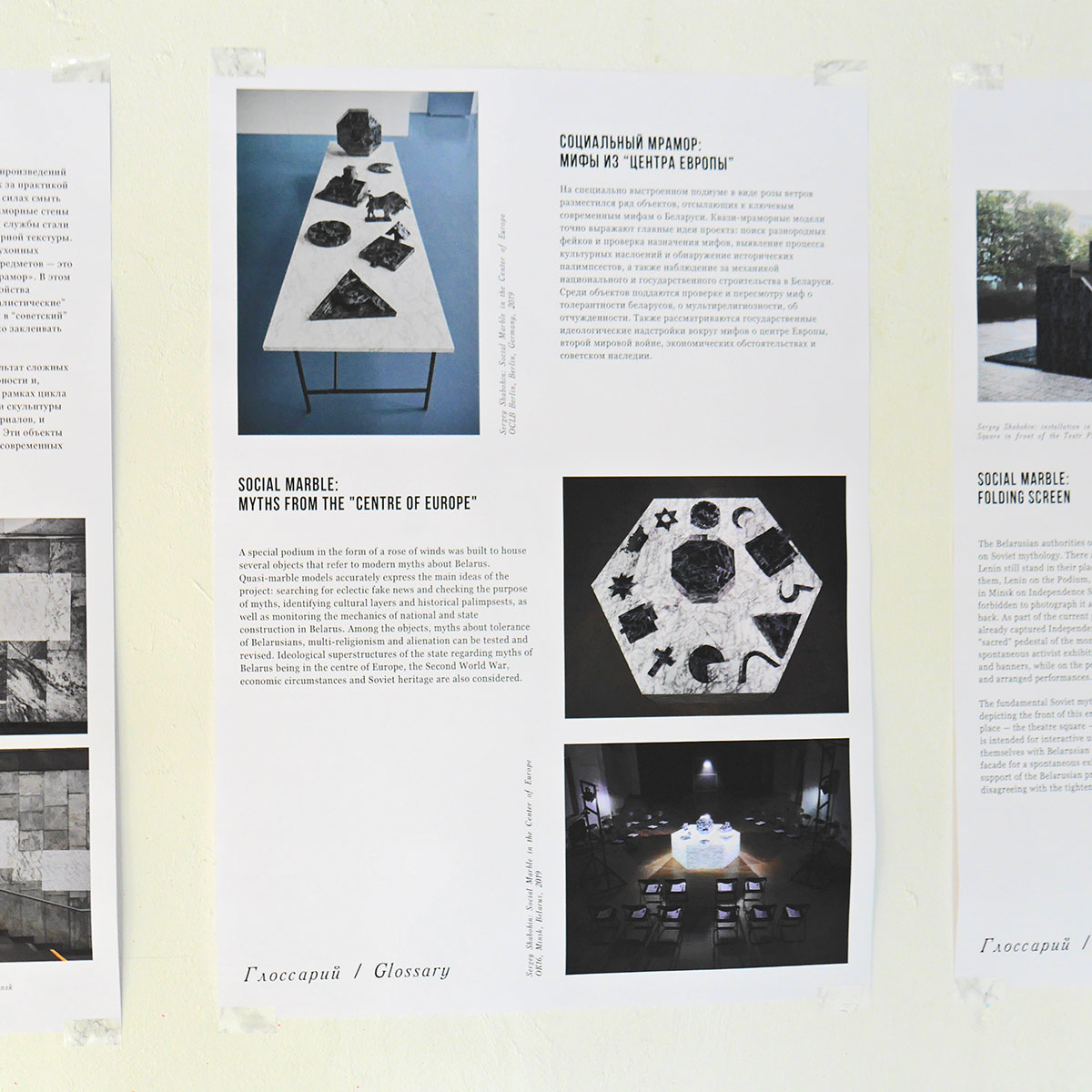
Glossary Social Marble #2
A special podium in the form of a rose of winds was built to house several objects that refer to modern myths about Belarus. Quasi-marble models accurately express the main ideas of the project: searching for eclectic fake news and checking the purpose of myths, identifying cultural layers and historical palimpsests, as well as monitoring the mechanics of national and state construction in Belarus. Among the objects, myths about tolerance of Belarusians, multi-religionism and alienation can be tested and revised. Ideological superstructures of the state regarding myths of Belarus being in the centre of Europe, the Second World War, economic circumstances and Soviet heritage are also considered.
Social Marble: Myths from the "Centre of Europe"
A special podium in the form of a rose of winds was built to house several objects that refer to modern myths about Belarus. Quasi-marble models accurately express the main ideas of the project: searching for eclectic fake news and checking the purpose of myths, identifying cultural layers and historical palimpsests, as well as monitoring the mechanics of national and state construction in Belarus. Among the objects, myths about tolerance of Belarusians, multi-religionism and alienation can be tested and revised. Ideological superstructures of the state regarding myths of Belarus being in the centre of Europe, the Second World War, economic circumstances and Soviet heritage are also considered.
Глоссарий “Социальный мрамор” #2
Социальный мрамор: мифы из “центра Европы”
На специально выстроенном подиуме в виде розы ветров разместился ряд объектов, отсылающих к ключевым современным мифам о Беларуси. Квази-мраморные модели точно выражают главные идеи проекта: поиск разнородных фейков и проверка назначения мифов, выявление процесса культурных наслоений и обнаружение исторических палимпсестов, а также наблюдение за механикой национального и государственного строительства в Беларуси. Среди объектов поддаются проверке и пересмотру миф о толерантности беларусов, о мультирелигиозности, об отчужденности. Также рассматриваются государственные идеологические надстройки вокруг мифов о центре Европы, второй мировой войне, экономических обстоятельствах и советском наследии.
Социальный мрамор: мифы из “центра Европы”
На специально выстроенном подиуме в виде розы ветров разместился ряд объектов, отсылающих к ключевым современным мифам о Беларуси. Квази-мраморные модели точно выражают главные идеи проекта: поиск разнородных фейков и проверка назначения мифов, выявление процесса культурных наслоений и обнаружение исторических палимпсестов, а также наблюдение за механикой национального и государственного строительства в Беларуси. Среди объектов поддаются проверке и пересмотру миф о толерантности беларусов, о мультирелигиозности, об отчужденности. Также рассматриваются государственные идеологические надстройки вокруг мифов о центре Европы, второй мировой войне, экономических обстоятельствах и советском наследии.
Fig. D1
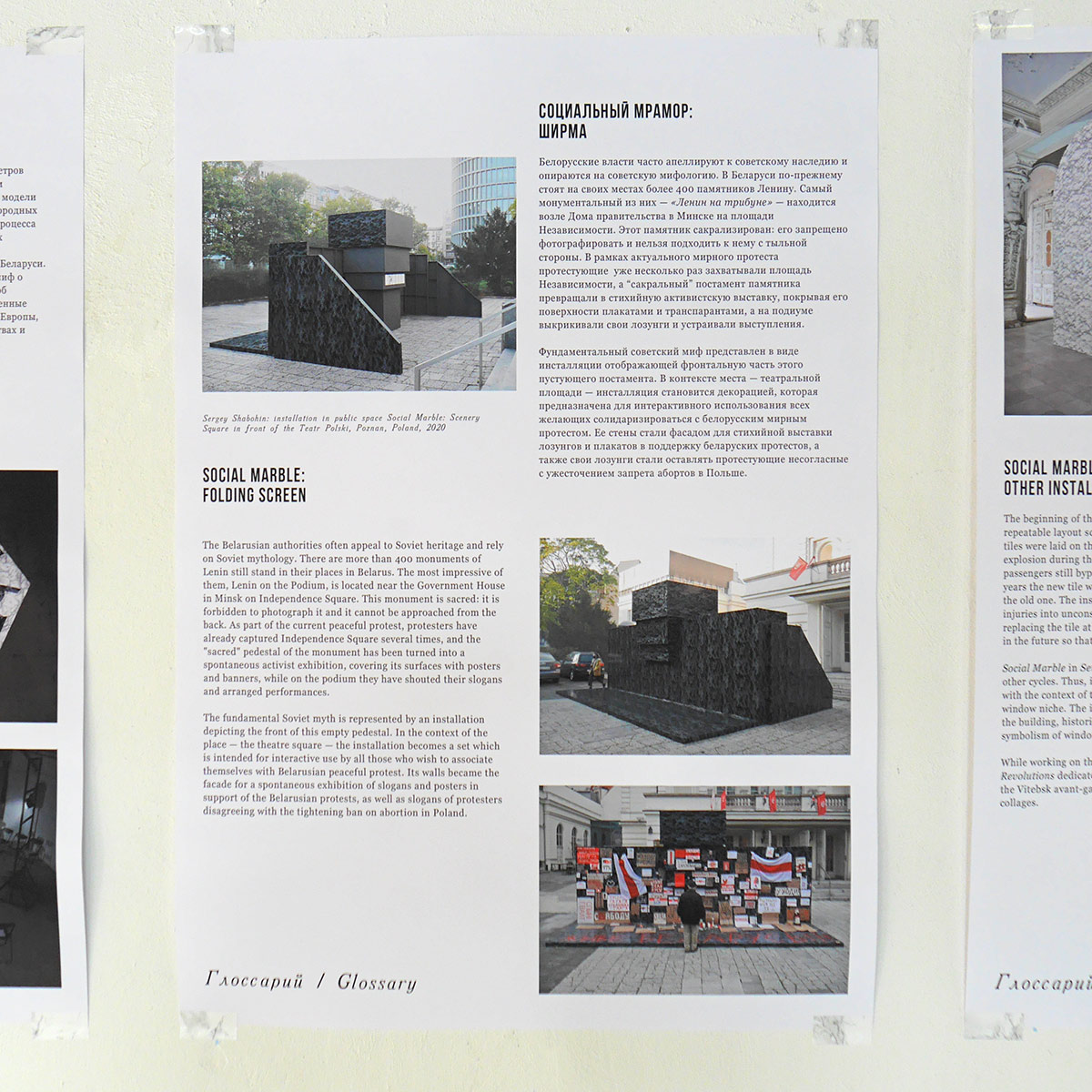
Glossary Social Marble #3
The Belarusian authorities often appeal to Soviet heritage and rely on Soviet mythology. There are more than 400 monuments of Lenin still stand in their places in Belarus. The most impressive of them, Lenin on the Podium, is located near the Government House in Minsk on Independence Square. This monument is sacred: it is forbidden to photograph it and it cannot be approached from the back. As part of the current peaceful protest, protesters have already captured Independence Square several times, and the "sacred" pedestal of the monument has been turned into a spontaneous activist exhibition, covering its surfaces with posters and banners, while on the podium they have shouted their slogans and arranged performances.
The fundamental Soviet myth is represented by an installation depicting the front of this empty pedestal. In the context of the place — the theatre square — the installation becomes a set which is intended for interactive use by all those who wish to associate themselves with Belarusian peaceful protest. Its walls became the facade for a spontaneous exhibition of slogans and posters in support of the Belarusian protests, as well as slogans of protesters disagreeing with the tightening ban on abortion in Poland.
Social Marble: Folding Screen
The Belarusian authorities often appeal to Soviet heritage and rely on Soviet mythology. There are more than 400 monuments of Lenin still stand in their places in Belarus. The most impressive of them, Lenin on the Podium, is located near the Government House in Minsk on Independence Square. This monument is sacred: it is forbidden to photograph it and it cannot be approached from the back. As part of the current peaceful protest, protesters have already captured Independence Square several times, and the "sacred" pedestal of the monument has been turned into a spontaneous activist exhibition, covering its surfaces with posters and banners, while on the podium they have shouted their slogans and arranged performances.
The fundamental Soviet myth is represented by an installation depicting the front of this empty pedestal. In the context of the place — the theatre square — the installation becomes a set which is intended for interactive use by all those who wish to associate themselves with Belarusian peaceful protest. Its walls became the facade for a spontaneous exhibition of slogans and posters in support of the Belarusian protests, as well as slogans of protesters disagreeing with the tightening ban on abortion in Poland.
Глоссарий “Социальный мрамор” #3
Социальный мрамор: ширма
Белорусские власти часто апеллируют к советскому наследию и опираются на советскую мифологию. В Беларуси по-прежнему стоят на своих местах более 400 памятников Ленину. Самый монументальный из них — «Ленин на трибуне» — находится возле Дома правительства в Минске на площади Независимости. Этот памятник сакрализирован: его запрещено фотографировать и нельзя подходить к нему с тыльной стороны. В рамках актуального мирного протеста протестующие уже несколько раз захватывали площадь Независимости, а “сакральный” постамент памятника превращали в стихийную активистскую выставку, покрывая его поверхности плакатами и транспарантами, а на подиуме выкрикивали свои лозунги и устраивали выступления.
Фундаментальный советский миф представлен в виде инсталляции отображающей фронтальную часть этого пустующего постамента. В контексте места — театральной площади — инсталляция становится декорацией, которая предназначена для интерактивного использования всех желающих солидаризироваться с белорусским мирным протестом. Ее стены стали фасадом для стихийной выставки лозунгов и плакатов в поддержку беларуских протестов, а также свои лозунги стали оставлять протестующие несогласные с ужесточением запрета абортов в Польше.
Социальный мрамор: ширма
Белорусские власти часто апеллируют к советскому наследию и опираются на советскую мифологию. В Беларуси по-прежнему стоят на своих местах более 400 памятников Ленину. Самый монументальный из них — «Ленин на трибуне» — находится возле Дома правительства в Минске на площади Независимости. Этот памятник сакрализирован: его запрещено фотографировать и нельзя подходить к нему с тыльной стороны. В рамках актуального мирного протеста протестующие уже несколько раз захватывали площадь Независимости, а “сакральный” постамент памятника превращали в стихийную активистскую выставку, покрывая его поверхности плакатами и транспарантами, а на подиуме выкрикивали свои лозунги и устраивали выступления.
Фундаментальный советский миф представлен в виде инсталляции отображающей фронтальную часть этого пустующего постамента. В контексте места — театральной площади — инсталляция становится декорацией, которая предназначена для интерактивного использования всех желающих солидаризироваться с белорусским мирным протестом. Ее стены стали фасадом для стихийной выставки лозунгов и плакатов в поддержку беларуских протестов, а также свои лозунги стали оставлять протестующие несогласные с ужесточением запрета абортов в Польше.
Fig. E1
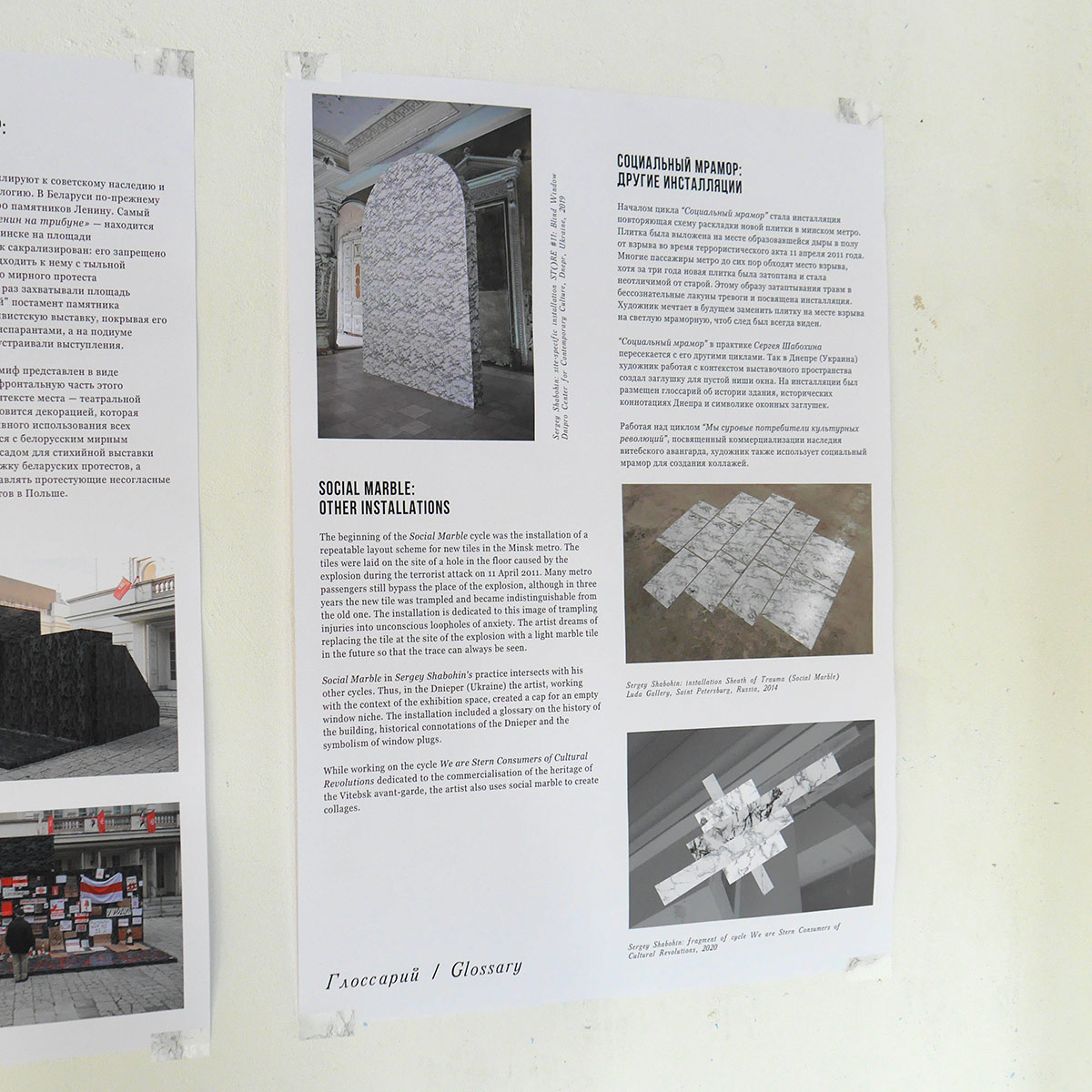
Glossary Social Marble #4
Social Marble: Other Installations
The beginning of the Social Marble cycle was the installation of a repeatable layout scheme for new tiles in the Minsk metro. The tiles were laid on the site of a hole in the floor caused by the explosion during the terrorist attack on 11 April 2011. Many metro passengers still bypass the place of the explosion, although in three years the new tile was trampled and became indistinguishable from the old one. The installation is dedicated to this image of trampling injuries into unconscious loopholes of anxiety. The artist dreams of replacing the tile at the site of the explosion with a light marble tile in the future so that the trace can always be seen.
Social Marble in Sergey Shabohin's practice intersects with his other cycles. Thus, in the Dnieper (Ukraine) the artist, working with the context of the exhibition space, created a cap for an empty window niche. The installation included a glossary on the history of the building, historical connotations of the Dnieper and the symbolism of window plugs.
While working on the cycle We are Stern Consumers of Cultural Revolutions dedicated to the commercialisation of the heritage of the Vitebsk avant-garde, the artist also uses social marble to create collages.
Social Marble: Other Installations
The beginning of the Social Marble cycle was the installation of a repeatable layout scheme for new tiles in the Minsk metro. The tiles were laid on the site of a hole in the floor caused by the explosion during the terrorist attack on 11 April 2011. Many metro passengers still bypass the place of the explosion, although in three years the new tile was trampled and became indistinguishable from the old one. The installation is dedicated to this image of trampling injuries into unconscious loopholes of anxiety. The artist dreams of replacing the tile at the site of the explosion with a light marble tile in the future so that the trace can always be seen.
Social Marble in Sergey Shabohin's practice intersects with his other cycles. Thus, in the Dnieper (Ukraine) the artist, working with the context of the exhibition space, created a cap for an empty window niche. The installation included a glossary on the history of the building, historical connotations of the Dnieper and the symbolism of window plugs.
While working on the cycle We are Stern Consumers of Cultural Revolutions dedicated to the commercialisation of the heritage of the Vitebsk avant-garde, the artist also uses social marble to create collages.
Глоссарий “Социальный мрамор” #4
Социальный мрамор: другие инсталляции
Началом цикла “Социальный мрамор” стала инсталляция повторяющая схему раскладки новой плитки в минском метро. Плитка была выложена на месте образовавшейся дыры в полу от взрыва во время террористического акта 11 апреля 2011 года. Многие пассажиры метро до сих пор обходят место взрыва, хотя за три года новая плитка была затоптана и стала неотличимой от старой. Этому образу затаптывания травм в бессознательные лакуны тревоги и посвящена инсталляция. Художник мечтает в будущем заменить плитку на месте взрыва на светлую мраморную, чтоб след был всегда виден.
“Социальный мрамор” в практике Сергея Шабохина пересекается с его другими циклами. Так в Днепре (Украина) художник работая с контекстом выставочного пространства создал заглушку для пустой ниши окна. На инсталляции был размещен глоссарий об истории здания, исторических коннотациях Днепра и символике оконных заглушек.
Работая над циклом “Мы суровые потребители культурных революций”, посвященный коммерциализации наследия витебского авангарда, художник также использует социальный мрамор для создания коллажей.
Социальный мрамор: другие инсталляции
Началом цикла “Социальный мрамор” стала инсталляция повторяющая схему раскладки новой плитки в минском метро. Плитка была выложена на месте образовавшейся дыры в полу от взрыва во время террористического акта 11 апреля 2011 года. Многие пассажиры метро до сих пор обходят место взрыва, хотя за три года новая плитка была затоптана и стала неотличимой от старой. Этому образу затаптывания травм в бессознательные лакуны тревоги и посвящена инсталляция. Художник мечтает в будущем заменить плитку на месте взрыва на светлую мраморную, чтоб след был всегда виден.
“Социальный мрамор” в практике Сергея Шабохина пересекается с его другими циклами. Так в Днепре (Украина) художник работая с контекстом выставочного пространства создал заглушку для пустой ниши окна. На инсталляции был размещен глоссарий об истории здания, исторических коннотациях Днепра и символике оконных заглушек.
Работая над циклом “Мы суровые потребители культурных революций”, посвященный коммерциализации наследия витебского авангарда, художник также использует социальный мрамор для создания коллажей.
Fig. F1
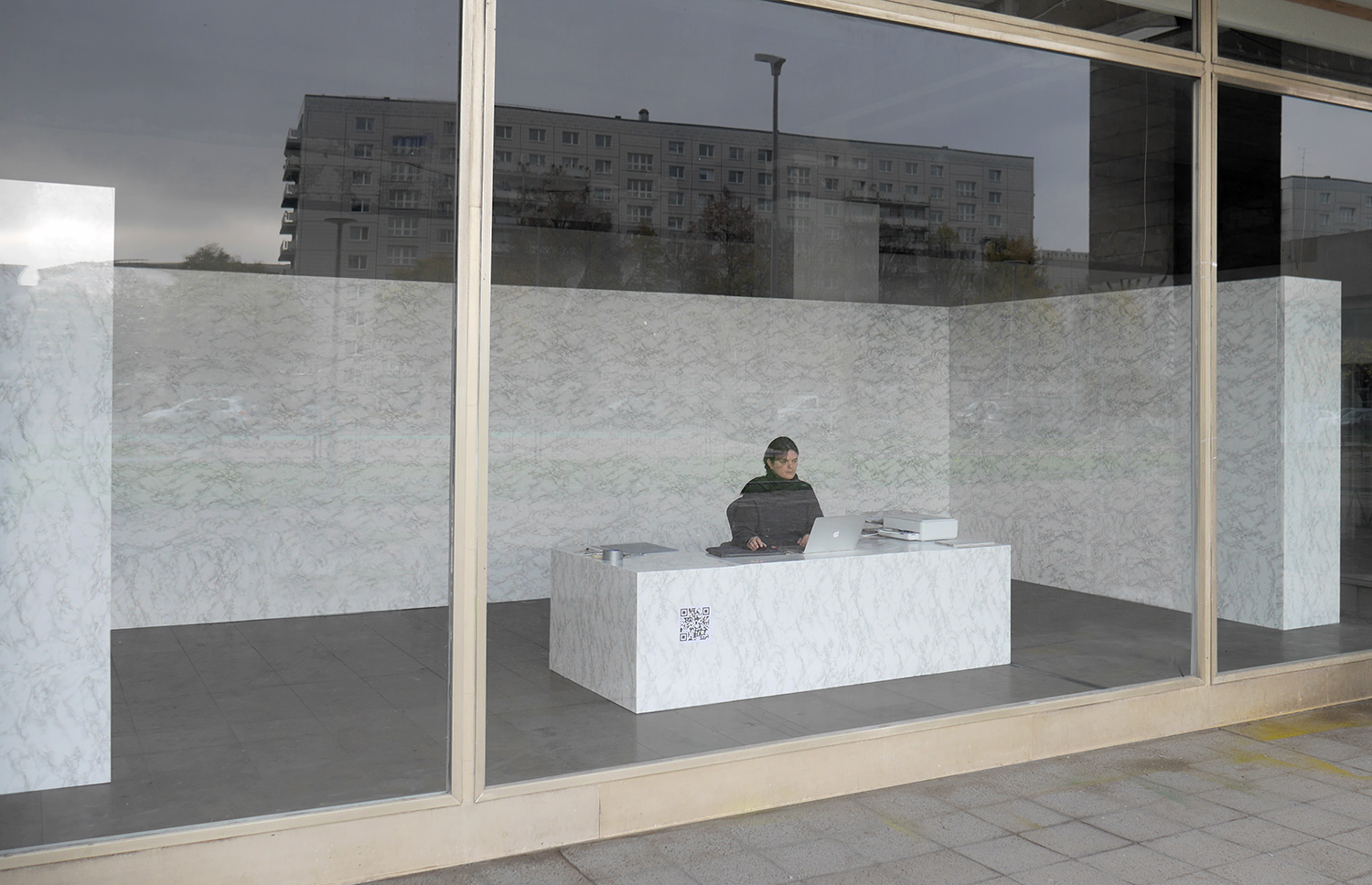
Photo of installation #1
Photo: Anna Limantava
November 1, 2020
Photo: Anna Limantava
Фото инсталляции #1
1 ноября 2020
Фото: Анна Лимантава
1 ноября 2020
Фото: Анна Лимантава
Fig. G1

Contributor #1
Olga Shparaga
Olga Shparaga studied Philosophy in Belarus and Germany. She currently curates the concentration “Contemporary Society, Ethics and Politics" at the European College of Liberal Arts, Minsk (Belarus, http://eclab.by) and teaches courses on a broad variety of philosophical themes. She was a Research Fellow at the Ruhr-University Bochum and Technical University of Freiburg (Germany), Centre for Theoretical Study (CTS, Prague, Czech Republic), at the Warsaw University of Technology (Poland) and New School of New York (USA).
She also serves as the co-coordinator of the Public Lectures Project “European Café” in Belarus (http://eurocafe.by, 2011-2016) and Co-editor of the Internet-magazine «Novaja Eŭropa» («New Europe») (www.n-europe.eu, 2006-2014).
Shparaga is member of the Editorial Board of the Ideology and Politics Journal (ideopol.org) and of the Belarusian Journal for the Contemporary art pARTisan, as well as of the Advisory Board of the "The Interlocutor. Journal of the Warsaw School of the History of Ideas" (http://theinterlocutor.fus-schuss.com).
Since August is a member of the Coordination Council initiated by the exiled presidential candidate Sviatlana Tsikhanouskaya in order to enable a peaceful and orderly transfer of power in Belarus. She received a 15 day sentence and after release on 24. October because of a new 12 day sentence was enforced to leave Belarus.
She has published numerous articles and the monograph «Wake of Political Life: An Essay on the Philosophy of the Public Sphere» (Vilnius: EHU, 2010, in Russian) and edited seven academic volumes, among which are: Feminist (Art)critique (co-edited with I. Solomatina and V. Hapeyeva), Kaunas: Taurapolis, 2015. — 680 p. (in Russian); Zero Radius. Art-ontology of the 00s, Minsk (co-edited with O. Jguirovskia and R. Vashkevich), Minsk: I.P. Logvinov, 2013. — 534 p. (in Russian and English); In the wake of Soviet Marxism: history, philosophy, sociology and psychoanalysis in national contexts (Belarus, Ukraine) (Ed.), Vilnius: EHU, 2013. — 288 p. (in Russian) and The ways of Europeanization of Belarus: between politics and identity construction (1991 — 2010) (Ed.), Minsk: I.P. Logvinov, 2011. — 278 p. (in Russian).
Lives and works in Minsk.
Olga Shparaga
Olga Shparaga studied Philosophy in Belarus and Germany. She currently curates the concentration “Contemporary Society, Ethics and Politics" at the European College of Liberal Arts, Minsk (Belarus, http://eclab.by) and teaches courses on a broad variety of philosophical themes. She was a Research Fellow at the Ruhr-University Bochum and Technical University of Freiburg (Germany), Centre for Theoretical Study (CTS, Prague, Czech Republic), at the Warsaw University of Technology (Poland) and New School of New York (USA).
She also serves as the co-coordinator of the Public Lectures Project “European Café” in Belarus (http://eurocafe.by, 2011-2016) and Co-editor of the Internet-magazine «Novaja Eŭropa» («New Europe») (www.n-europe.eu, 2006-2014).
Shparaga is member of the Editorial Board of the Ideology and Politics Journal (ideopol.org) and of the Belarusian Journal for the Contemporary art pARTisan, as well as of the Advisory Board of the "The Interlocutor. Journal of the Warsaw School of the History of Ideas" (http://theinterlocutor.fus-schuss.com).
Since August is a member of the Coordination Council initiated by the exiled presidential candidate Sviatlana Tsikhanouskaya in order to enable a peaceful and orderly transfer of power in Belarus. She received a 15 day sentence and after release on 24. October because of a new 12 day sentence was enforced to leave Belarus.
She has published numerous articles and the monograph «Wake of Political Life: An Essay on the Philosophy of the Public Sphere» (Vilnius: EHU, 2010, in Russian) and edited seven academic volumes, among which are: Feminist (Art)critique (co-edited with I. Solomatina and V. Hapeyeva), Kaunas: Taurapolis, 2015. — 680 p. (in Russian); Zero Radius. Art-ontology of the 00s, Minsk (co-edited with O. Jguirovskia and R. Vashkevich), Minsk: I.P. Logvinov, 2013. — 534 p. (in Russian and English); In the wake of Soviet Marxism: history, philosophy, sociology and psychoanalysis in national contexts (Belarus, Ukraine) (Ed.), Vilnius: EHU, 2013. — 288 p. (in Russian) and The ways of Europeanization of Belarus: between politics and identity construction (1991 — 2010) (Ed.), Minsk: I.P. Logvinov, 2011. — 278 p. (in Russian).
Lives and works in Minsk.
Контрибьюторка #1
Философка, кандидат философских наук, руководительница концентрации «Современное общество, этика и политика» ECLAB. Училась философии в Беларуси и Германии. Входит в научный совет журналов the Ideology and Politics Journal, The Interlocutor и pARTisanкА. Занималась научными исследованиями в Рурском университете г. Бохума, в университете Генриха Гейне г. Дюссельдорфа и в университете г. Фрайбурга (Германия), в Центре теоретических исследований в Праге, Технологическом университете Варшавы и в The New School (Нью-Йорк, США).
Монография Ольги Шпараги «Сообщество-после-Холокоста: на пути к обществу инклюзии» (Минск: Медисонт, ECLAB-Books, 2018) была признана лучшей философской монографией 2018 года Международным Конгрессом исследователей Беларуси, а также вошла в шорт лист «Книга года 2018» Беларусского Пен-центра.
С августа входит в Фем группу Координационного Совета беларусской оппозиции. Провела в октябре 15 дней в тюрьме и была осуждена на новые 12 дней, из-за чего была вынуждена уехать из страны.
Ольга Шпарага также является научной (со)редакторкой семи коллективных монографий, среди которых:
Феминистская (арт)критика / под ред. И. Соломатина, О. Шпарага, В. Гапеева, Каунас: Taurapolis, 2015.
Радиус нуля. Онтология арт-нулевых. Минск, 2000-2010 / под ред. О. Жгировской, О. Шпараги, Р. Вашкевича. Минск: Логвинов, 2013 — 532 с.
После советского марксизма: история, философия, социология и психоанализ в национальных контекстах (Беларусь, Украина) / сост., науч. ред. О. Шпарага. Вильнюс: ЕГУ, 2013.
Пути европеизации Беларуси: между политикой и конструированием идентичности (1991 — 2010). Под ред. О. Шпараги. Минск: Логвинов, 2011.
Живет и работает в Минске.
Ольга Шпарага
Философка, кандидат философских наук, руководительница концентрации «Современное общество, этика и политика» ECLAB. Училась философии в Беларуси и Германии. Входит в научный совет журналов the Ideology and Politics Journal, The Interlocutor и pARTisanкА. Занималась научными исследованиями в Рурском университете г. Бохума, в университете Генриха Гейне г. Дюссельдорфа и в университете г. Фрайбурга (Германия), в Центре теоретических исследований в Праге, Технологическом университете Варшавы и в The New School (Нью-Йорк, США).
Монография Ольги Шпараги «Сообщество-после-Холокоста: на пути к обществу инклюзии» (Минск: Медисонт, ECLAB-Books, 2018) была признана лучшей философской монографией 2018 года Международным Конгрессом исследователей Беларуси, а также вошла в шорт лист «Книга года 2018» Беларусского Пен-центра.
С августа входит в Фем группу Координационного Совета беларусской оппозиции. Провела в октябре 15 дней в тюрьме и была осуждена на новые 12 дней, из-за чего была вынуждена уехать из страны.
Ольга Шпарага также является научной (со)редакторкой семи коллективных монографий, среди которых:
Феминистская (арт)критика / под ред. И. Соломатина, О. Шпарага, В. Гапеева, Каунас: Taurapolis, 2015.
Радиус нуля. Онтология арт-нулевых. Минск, 2000-2010 / под ред. О. Жгировской, О. Шпараги, Р. Вашкевича. Минск: Логвинов, 2013 — 532 с.
После советского марксизма: история, философия, социология и психоанализ в национальных контекстах (Беларусь, Украина) / сост., науч. ред. О. Шпарага. Вильнюс: ЕГУ, 2013.
Пути европеизации Беларуси: между политикой и конструированием идентичности (1991 — 2010). Под ред. О. Шпараги. Минск: Логвинов, 2011.
Живет и работает в Минске.
Fig. H1
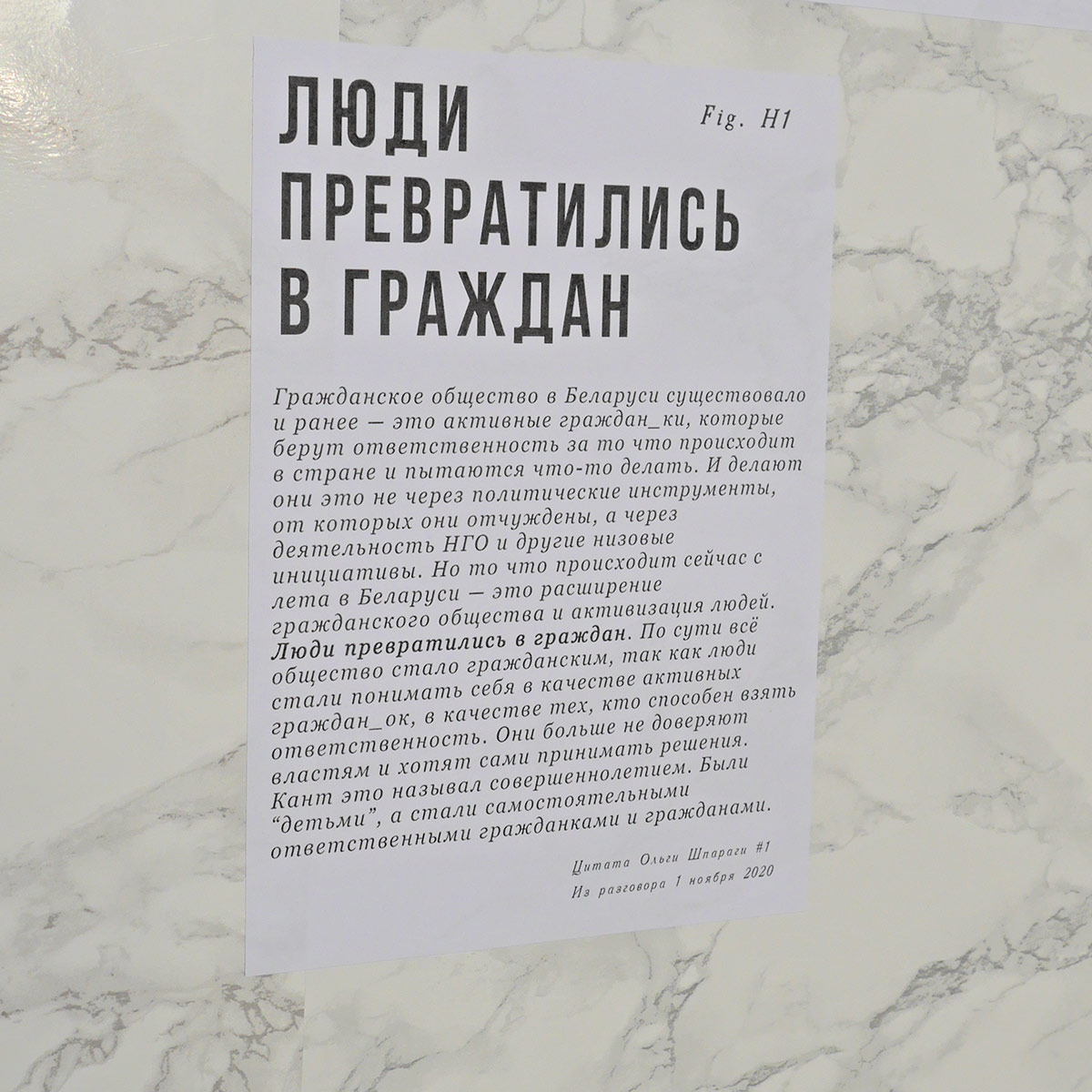
Quote by Olga Shparaga #1
Civil society has existed in Belarus before – active citizens who take responsibility for what is happening in the country and try to do something. And they do it not through political instruments, from which they are alienated, but through the activities of NGOs and other grassroots initiatives. But what has been happening in Belarus since this summer is the expansion of civil society and activisation of people. People have turned into citizens. In fact, the whole society has become civil, because people have started to understand themselves as active citizens, as those who are able to take responsibility. They no longer trust the authorities and want to make their own decisions. Kant called this the age of majority. Former "children", but they became independent, responsible citizens now.
From a conversation on the 1st of November 2020
People Have Turned Into Citizens
Civil society has existed in Belarus before – active citizens who take responsibility for what is happening in the country and try to do something. And they do it not through political instruments, from which they are alienated, but through the activities of NGOs and other grassroots initiatives. But what has been happening in Belarus since this summer is the expansion of civil society and activisation of people. People have turned into citizens. In fact, the whole society has become civil, because people have started to understand themselves as active citizens, as those who are able to take responsibility. They no longer trust the authorities and want to make their own decisions. Kant called this the age of majority. Former "children", but they became independent, responsible citizens now.
From a conversation on the 1st of November 2020
Цитата Ольги Шпараги #1
Люди превратились в граждан
Гражданское общество в Беларуси существовало и ранее — это активные граждан_ки, которые берут ответственность за то, что происходит в стране и пытаются что-то делать. И делают они это не через политические инструменты, от которых они отчуждены, а через деятельность НГО и другие низовые инициативы. Но то, что происходит сейчас с лета в Беларуси — это расширение гражданского общества и активизация людей. Люди превратились в граждан. По сути всё общество стало гражданским, так как люди стали понимать себя в качестве активных граждан_ок, в качестве тех, кто способен взять ответственность. Они больше не доверяют властям и хотят сами принимать решения. Кант это называл совершеннолетием. Были “детьми”, а стали самостоятельными ответственными гражданками и гражданами.
Из разговора 1 ноября 2020
Люди превратились в граждан
Гражданское общество в Беларуси существовало и ранее — это активные граждан_ки, которые берут ответственность за то, что происходит в стране и пытаются что-то делать. И делают они это не через политические инструменты, от которых они отчуждены, а через деятельность НГО и другие низовые инициативы. Но то, что происходит сейчас с лета в Беларуси — это расширение гражданского общества и активизация людей. Люди превратились в граждан. По сути всё общество стало гражданским, так как люди стали понимать себя в качестве активных граждан_ок, в качестве тех, кто способен взять ответственность. Они больше не доверяют властям и хотят сами принимать решения. Кант это называл совершеннолетием. Были “детьми”, а стали самостоятельными ответственными гражданками и гражданами.
Из разговора 1 ноября 2020
Fig. I1
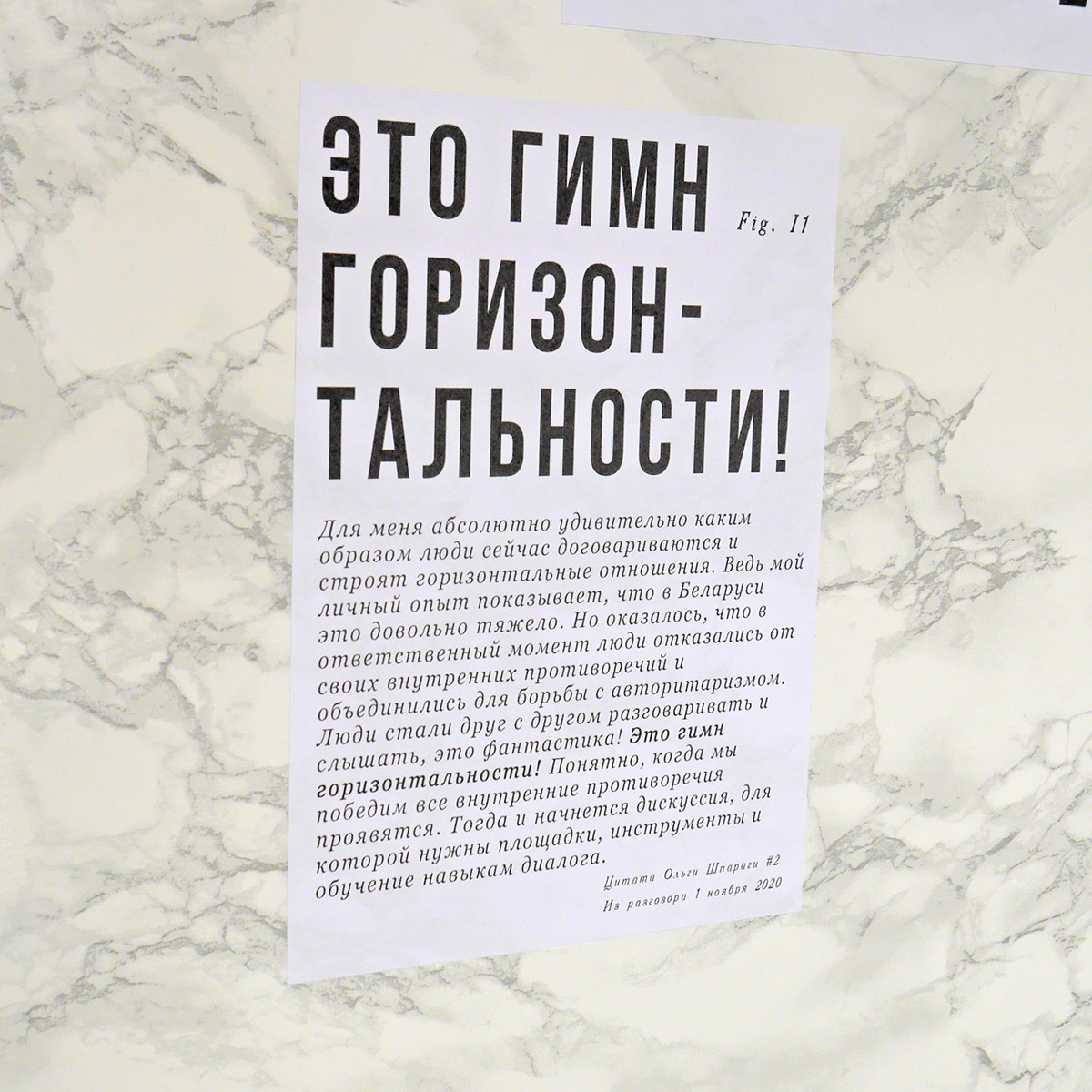
Quote by Olga Shparaga #2
For me, it's absolutely amazing how people now negotiate and build horizontal relationships. My personal experience shows that it is quite a difficult issue in Belarus. But it turned out that at a crucial moment people gave up their internal contradictions and united to fight authoritarianism. People started talking and listening to each other, it's fantastic! This is an anthem of horizontality! It is clear: after we win the internal contradictions will come back. That's when the discussion begins, for which you need platforms, tools and training in dialogue skills.
From the conversation on the 1st of November 2020
This is a Anthem of Horizontality!
For me, it's absolutely amazing how people now negotiate and build horizontal relationships. My personal experience shows that it is quite a difficult issue in Belarus. But it turned out that at a crucial moment people gave up their internal contradictions and united to fight authoritarianism. People started talking and listening to each other, it's fantastic! This is an anthem of horizontality! It is clear: after we win the internal contradictions will come back. That's when the discussion begins, for which you need platforms, tools and training in dialogue skills.
From the conversation on the 1st of November 2020
Цитата Ольги Шпараги #2
Это гимн горизонтальности!
Для меня абсолютно удивительно каким образом люди сейчас договариваются и строят горизонтальные отношения. Ведь мой личный опыт показывает, что в Беларуси это довольно тяжело. Но оказалось, что в ответственный момент люди отказались от своих внутренних противоречий и объединились для борьбы с авторитаризмом. Люди стали друг с другом разговаривать и слышать — это фантастика! Это гимн горизонтальности! Понятно, когда мы победим, то все внутренние противоречия проявятся. Тогда и начнется дискуссия, для которой нужны площадки, инструменты и обучение навыкам диалога.
Из разговора 1 ноября 2020
Это гимн горизонтальности!
Для меня абсолютно удивительно каким образом люди сейчас договариваются и строят горизонтальные отношения. Ведь мой личный опыт показывает, что в Беларуси это довольно тяжело. Но оказалось, что в ответственный момент люди отказались от своих внутренних противоречий и объединились для борьбы с авторитаризмом. Люди стали друг с другом разговаривать и слышать — это фантастика! Это гимн горизонтальности! Понятно, когда мы победим, то все внутренние противоречия проявятся. Тогда и начнется дискуссия, для которой нужны площадки, инструменты и обучение навыкам диалога.
Из разговора 1 ноября 2020
Fig. J1
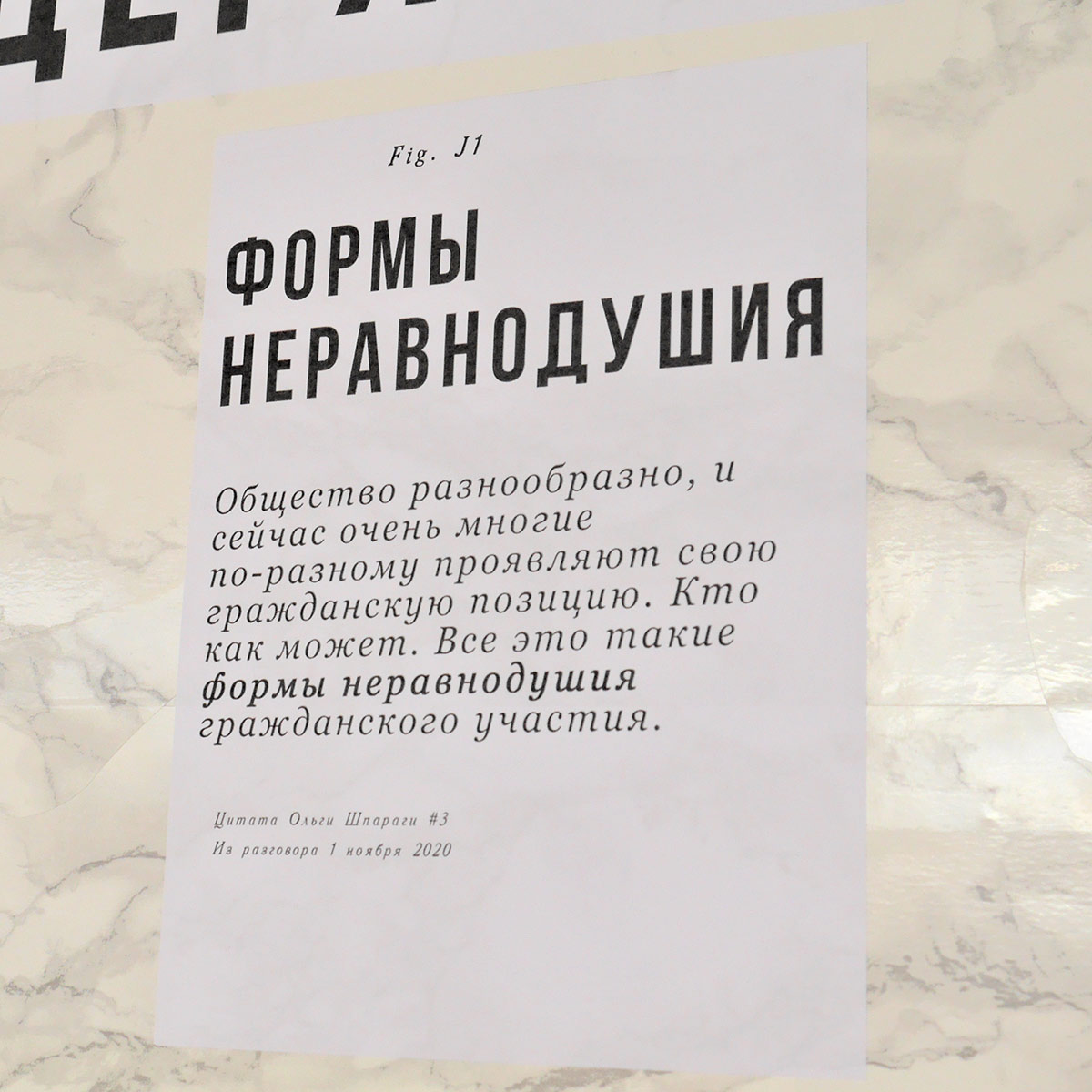
Quote by Olga Shparaga #3
Forms of Nonindifference
Society is diverse, and there are many different ways in which people now demonstrate their civic position. Everyone as they can. These are all forms of nonindifference, of civic engagement.
From a conversation on the 1st of November 2020.
Forms of Nonindifference
Society is diverse, and there are many different ways in which people now demonstrate their civic position. Everyone as they can. These are all forms of nonindifference, of civic engagement.
From a conversation on the 1st of November 2020.
Цитата Ольги Шпараги #3
Общество разнообразно, и сейчас очень многие по-разному проявляют свою гражданскую позицию. Кто как может. Все это такие формы неравнодушия гражданского участия.
Из разговора 1 ноября 2020
Формы неравнодушия
Общество разнообразно, и сейчас очень многие по-разному проявляют свою гражданскую позицию. Кто как может. Все это такие формы неравнодушия гражданского участия.
Из разговора 1 ноября 2020
Fig. K1

Quote by Olga Shparaga #4
What has happened now - has shown an unbridgeable gap between society and the authorities. Obviously, people's attitudes towards violence have changed in the past 26 years whereas the authorities have still the same response to conflict resolution as ever: violence, rudeness, humiliation and dehumanisation of citizens. People have jumped over the abyss of violence. And now the society and the self-proclaimed auhority are standing on different sides of this abyss, while the authorities continue to try to drag citizens into it through prisons, humiliation and forced exile.
From a conversation on the 1st of November 2020
Abyss of Violence
What has happened now - has shown an unbridgeable gap between society and the authorities. Obviously, people's attitudes towards violence have changed in the past 26 years whereas the authorities have still the same response to conflict resolution as ever: violence, rudeness, humiliation and dehumanisation of citizens. People have jumped over the abyss of violence. And now the society and the self-proclaimed auhority are standing on different sides of this abyss, while the authorities continue to try to drag citizens into it through prisons, humiliation and forced exile.
From a conversation on the 1st of November 2020
Цитата Ольги Шпараги #4
То что сейчас произошло — продемонстрировало непреодолимую пропасть между обществом и властями. Очевидно, что у людей за 26 лет изменилось отношение к насилию, а у властей на решение конфликтов все один и тот же ответ — насилие, грубость, унижения и дегуманизация граждан. Люди пропасть насилия перепрыгнули. И сейчас общество с самопровозглашенной властью стоят на разных сторонах этой пропасти, а власть продолжает пытаться затянуть в нее граждан через тюрьмы, унижение, изгнание из страны.
Из разговора 1 ноября 2020
Пропасть насилия
То что сейчас произошло — продемонстрировало непреодолимую пропасть между обществом и властями. Очевидно, что у людей за 26 лет изменилось отношение к насилию, а у властей на решение конфликтов все один и тот же ответ — насилие, грубость, унижения и дегуманизация граждан. Люди пропасть насилия перепрыгнули. И сейчас общество с самопровозглашенной властью стоят на разных сторонах этой пропасти, а власть продолжает пытаться затянуть в нее граждан через тюрьмы, унижение, изгнание из страны.
Из разговора 1 ноября 2020
Fig. L1
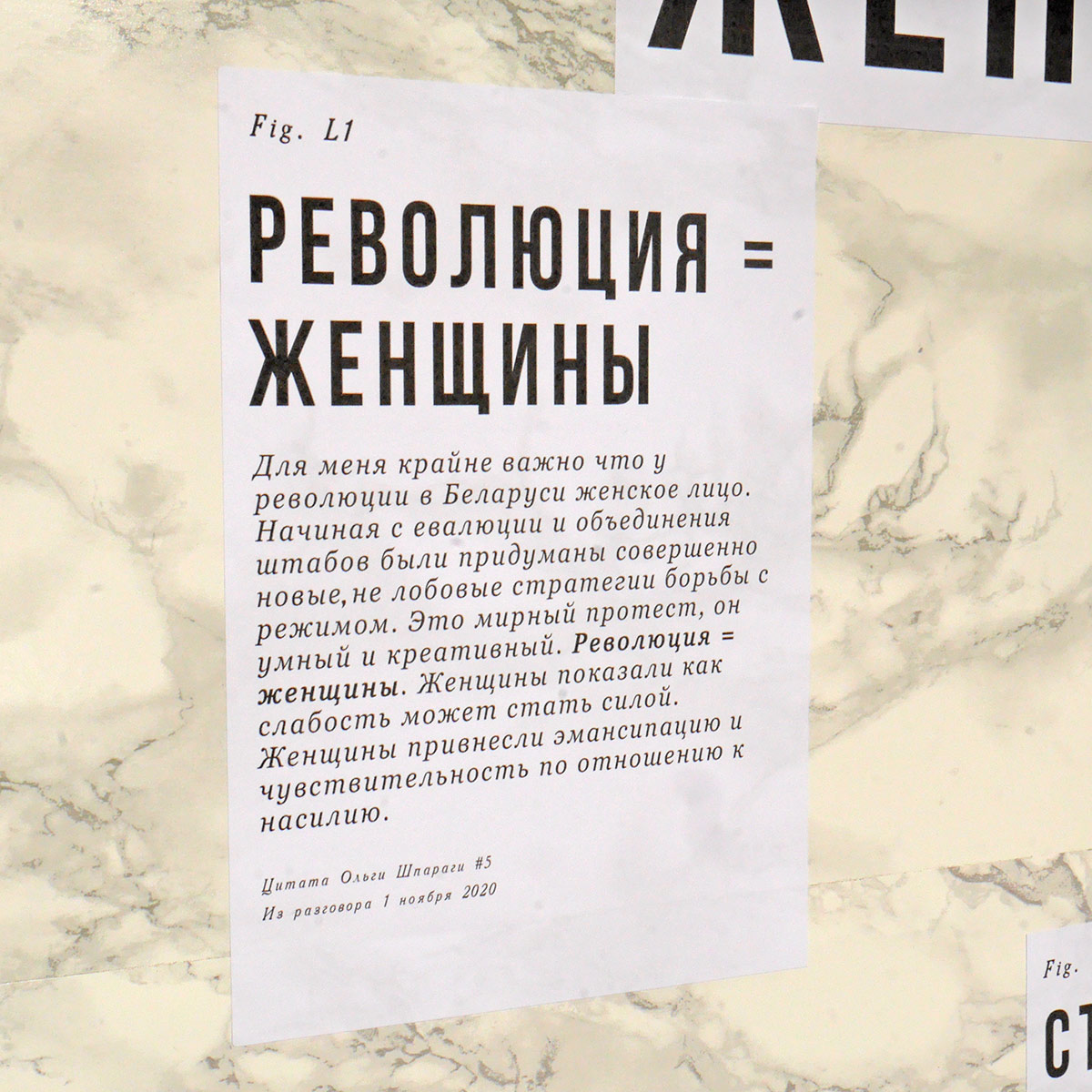
Quote by Olga Shparaga #5
It is extremely important for me that the revolution in Belarus has a woman's face. From the beginning when the campaign offices consolidated, new innovative strategies for fighting the regime were invented. This is a peaceful protest, smart and creative. Revolution means women. Women have shown how weakness can become strength. Women brought in emancipation and sensitivity to violence.
From a conversation on the 1st of November 2020
Revolution = Woman
It is extremely important for me that the revolution in Belarus has a woman's face. From the beginning when the campaign offices consolidated, new innovative strategies for fighting the regime were invented. This is a peaceful protest, smart and creative. Revolution means women. Women have shown how weakness can become strength. Women brought in emancipation and sensitivity to violence.
From a conversation on the 1st of November 2020
Цитата Ольги Шпараги #5
Для меня крайне важно что у революции в Беларуси женское лицо. Начиная с евалюции и объединения штабов были придуманы совершенно новые, не лобовые стратегии борьбы с режимом. Это мирный протест, он умный и креативный. Революция = женщины. Женщины показали как слабость может стать силой. Женщины привнесли эмансипацию и чувствительность по отношению к насилию.
Из разговора 1 ноября 2020
Революция = женщины
Для меня крайне важно что у революции в Беларуси женское лицо. Начиная с евалюции и объединения штабов были придуманы совершенно новые, не лобовые стратегии борьбы с режимом. Это мирный протест, он умный и креативный. Революция = женщины. Женщины показали как слабость может стать силой. Женщины привнесли эмансипацию и чувствительность по отношению к насилию.
Из разговора 1 ноября 2020
Fig. M1
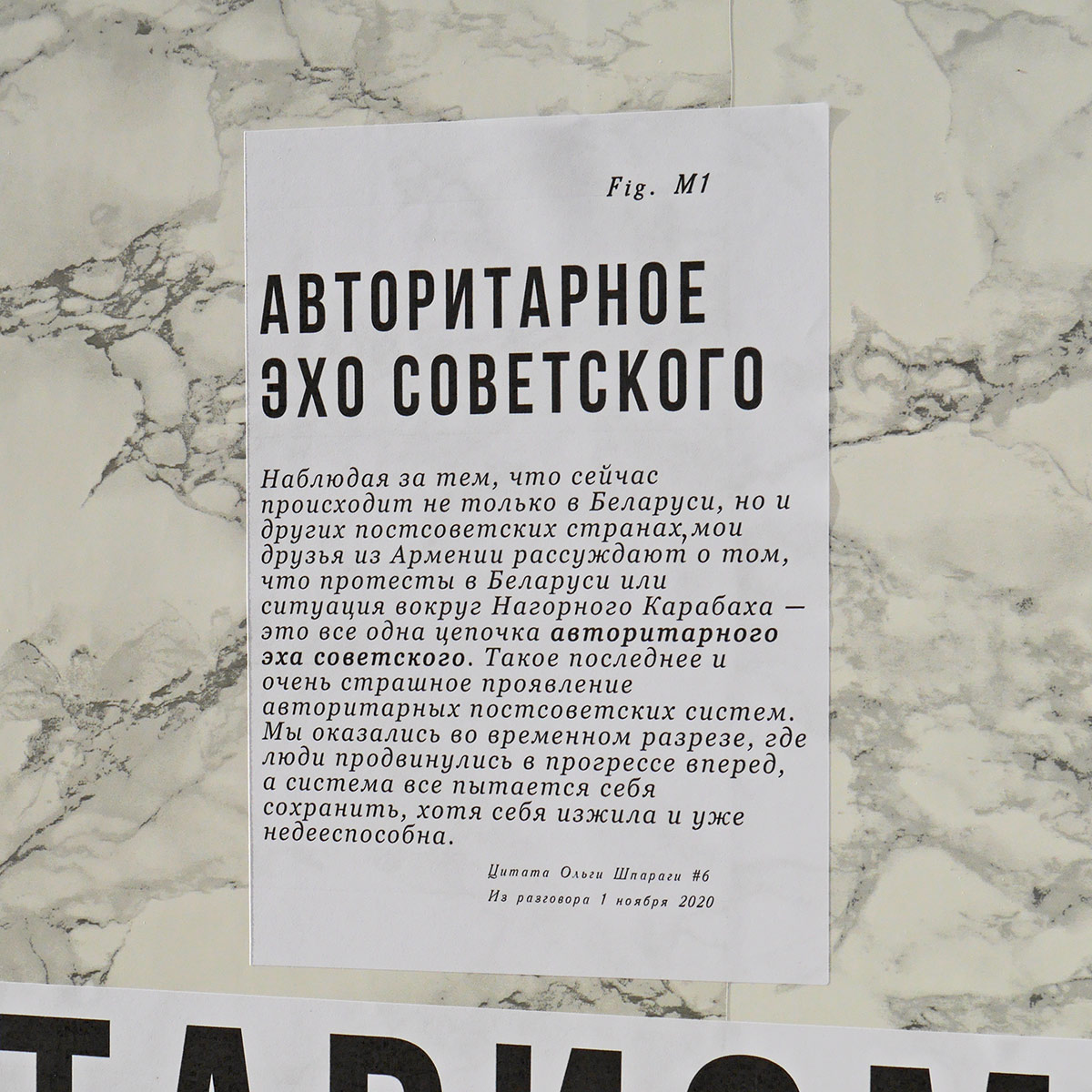
Quote by Olga Shparaga # 6
Observing what is happening now not only in Belarus, but also in other post-Soviet countries, my friends from Armenia say that the protests in Belarus or the situation in Nagorno-Karabakh are both the authoritarian echo of the Soviet regime. This is the latest and very terrifying manifestation of the authoritarian post-Soviet systems. We found ourselves in times where people have moved forward in progress while the system is still trying to preserve itself, although it has outlived itself and is already inefficient.
From a conversation on the 1st of November 2020
The Authoritarian Echo of the Soviet Regime
Observing what is happening now not only in Belarus, but also in other post-Soviet countries, my friends from Armenia say that the protests in Belarus or the situation in Nagorno-Karabakh are both the authoritarian echo of the Soviet regime. This is the latest and very terrifying manifestation of the authoritarian post-Soviet systems. We found ourselves in times where people have moved forward in progress while the system is still trying to preserve itself, although it has outlived itself and is already inefficient.
From a conversation on the 1st of November 2020
Цитата Ольги Шпараги #6
Наблюдая за тем, что сейчас происходит не только в Беларуси, но и в других постсоветских странах, мои друзья из Армении рассуждают о том, что протесты в Беларуси или ситуация вокруг Нагорного Карабаха — это все одна цепочка авторитарного эха советского. Такое последнее и очень страшное проявление авторитарных постсоветских систем. Мы оказались во временном разрезе, где люди продвинулись в прогрессе вперед, а система все пытается себя сохранить, хотя себя изжила и уже недееспособна.
Из разговора 1 ноября 2020
Авторитарное эхо советского
Наблюдая за тем, что сейчас происходит не только в Беларуси, но и в других постсоветских странах, мои друзья из Армении рассуждают о том, что протесты в Беларуси или ситуация вокруг Нагорного Карабаха — это все одна цепочка авторитарного эха советского. Такое последнее и очень страшное проявление авторитарных постсоветских систем. Мы оказались во временном разрезе, где люди продвинулись в прогрессе вперед, а система все пытается себя сохранить, хотя себя изжила и уже недееспособна.
Из разговора 1 ноября 2020
Fig. N1

Favorite Slogan # 1
All these slogans - "No Means No!", "If He Beats, He’ll Be Imprisoned!" - they are from the feminist agenda. And at one of Sunday's protest marches I saw a middle-aged man with this classic feminist slogan. Lukashenko says that he holds Belarus with his blue fingers like a woman whom he does not want to let go. What can you say to this? One can only look at it from a feminist angle and demand the end of domestic violence projected like the state “domestic tyranny”.
From a conversation on the 1st of November 2020
If He Beats, He’ll Be Imprisoned!
All these slogans - "No Means No!", "If He Beats, He’ll Be Imprisoned!" - they are from the feminist agenda. And at one of Sunday's protest marches I saw a middle-aged man with this classic feminist slogan. Lukashenko says that he holds Belarus with his blue fingers like a woman whom he does not want to let go. What can you say to this? One can only look at it from a feminist angle and demand the end of domestic violence projected like the state “domestic tyranny”.
From a conversation on the 1st of November 2020
Избранный лозунг #1
Все эти лозунги — “Нет значит нет!”, “Бьёт значит сядет!” — они пришли из феминистской повестки. И я видела на акции мужчину средних лет с этим классическим феминистическим лозунгом, который пришел на один из воскресных маршей протеста. Лукашенко говорит, что он держит Беларусь своими синими пальцами как женщину, которую не желает отпускать. Вот что на это отвечать? Можно только использовать фем-оптику и призывать к окончанию домашнего насилия в лице государственной “домашней тирании”.
Ольга Шпарага, из разговора 1 ноября 2020
Бьёт значит сядет!
Все эти лозунги — “Нет значит нет!”, “Бьёт значит сядет!” — они пришли из феминистской повестки. И я видела на акции мужчину средних лет с этим классическим феминистическим лозунгом, который пришел на один из воскресных маршей протеста. Лукашенко говорит, что он держит Беларусь своими синими пальцами как женщину, которую не желает отпускать. Вот что на это отвечать? Можно только использовать фем-оптику и призывать к окончанию домашнего насилия в лице государственной “домашней тирании”.
Ольга Шпарага, из разговора 1 ноября 2020
Fig. O1

Quote by Olga Shparaga # 7
It is important how technology is used in the protest. This smart and creative protest is becoming the way to build digital democracy, as we will use all these technological tools in the future. The IT industry played an important role here, which is important. The telegam phenomenon of the “Нехта” channel and the platform “Voice” is unprecedented. We are living in the twenties of the XXI century and the best that the modern world has to offer Belarusians have used in protests. We use all advantages of progress.
From a conversation on the 1st of November 2020
Digital Democracy
It is important how technology is used in the protest. This smart and creative protest is becoming the way to build digital democracy, as we will use all these technological tools in the future. The IT industry played an important role here, which is important. The telegam phenomenon of the “Нехта” channel and the platform “Voice” is unprecedented. We are living in the twenties of the XXI century and the best that the modern world has to offer Belarusians have used in protests. We use all advantages of progress.
From a conversation on the 1st of November 2020
Цитата Ольги Шпараги #7
Цифровая демократия
Важным является то, как в рамках протеста используются технологии. Этот умный и креативный протест становится образом для построения цифровой демократии, ведь все эти технологические инструменты мы будем использовать в будущем. It-сегмент здесь сыграл немаловажную роль, что важно. Феномен telegram канала “Нехта” и платформы “Голос” беспрецедентны. Мы живём в двадцатые годы XXI века и самое лучшее, что предлагает современность, беларус_ки взяли для протестов. Мы пользуемся всеми наработками прогресса.
Из разговора 1 ноября 2020
Fig. P1
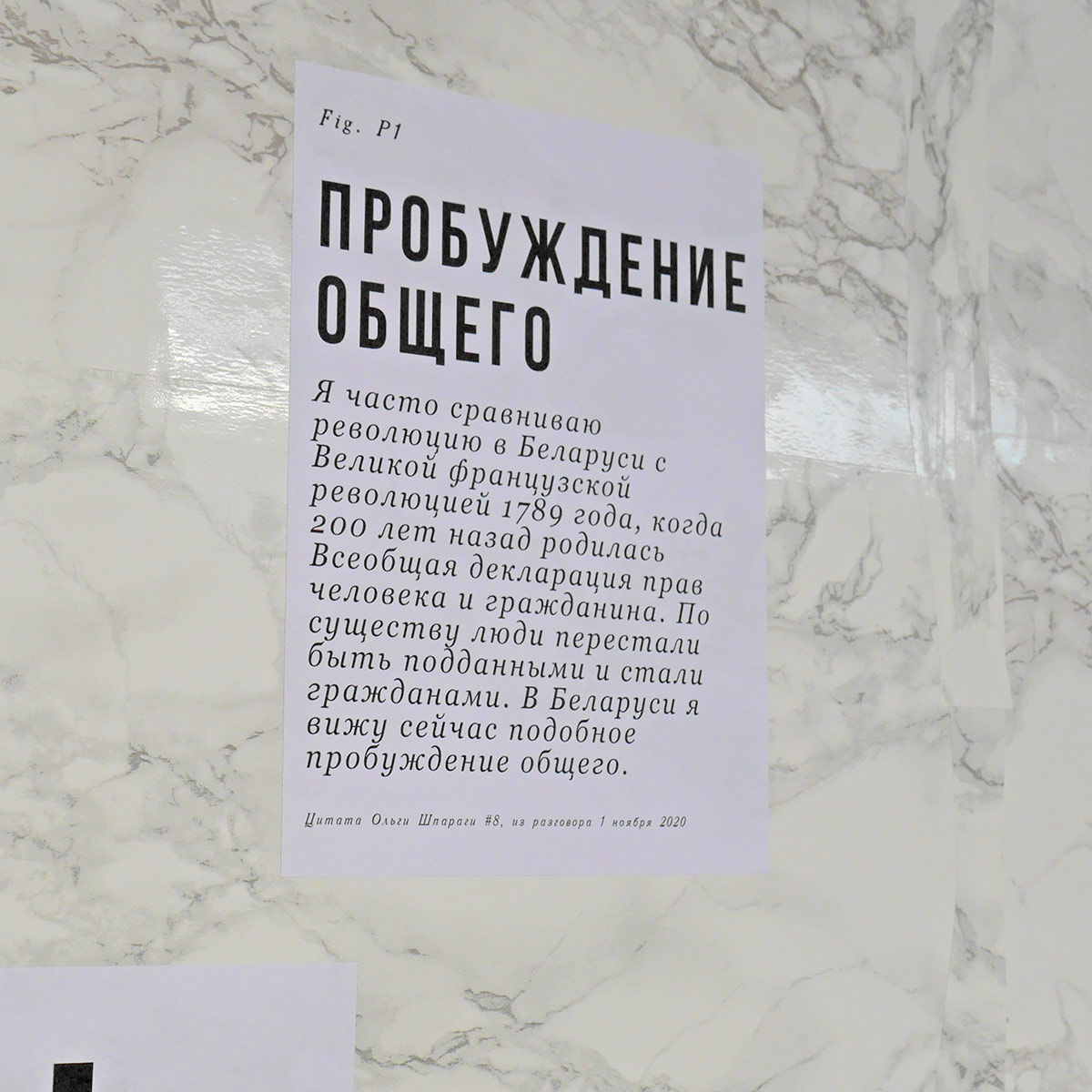
Quote by Olga Shparaga #8
I often compare the revolution in Belarus with the Great French Revolution of 1789, when the Universal Declaration of Human and Civil Rights was born 200 years ago. In essence, people ceased to be subjects and became citizens. In Belarus, I see now a similar awakening of the common.
From a conversation on the 1st of November 2020
Awakening the Commonplace
I often compare the revolution in Belarus with the Great French Revolution of 1789, when the Universal Declaration of Human and Civil Rights was born 200 years ago. In essence, people ceased to be subjects and became citizens. In Belarus, I see now a similar awakening of the common.
From a conversation on the 1st of November 2020
Цитата Ольги Шпараги #8
Я часто сравниваю революцию в Беларуси с Великой французской революцией 1789 года, когда 200 лет назад родилась Всеобщая декларация прав человека и гражданина. По существу люди перестали быть подданными и стали гражданами. В Беларуси я вижу сейчас подобное пробуждение общего.
Из разговора 1 ноября 2020
Пробуждение общего
Я часто сравниваю революцию в Беларуси с Великой французской революцией 1789 года, когда 200 лет назад родилась Всеобщая декларация прав человека и гражданина. По существу люди перестали быть подданными и стали гражданами. В Беларуси я вижу сейчас подобное пробуждение общего.
Из разговора 1 ноября 2020
Fig. Q1
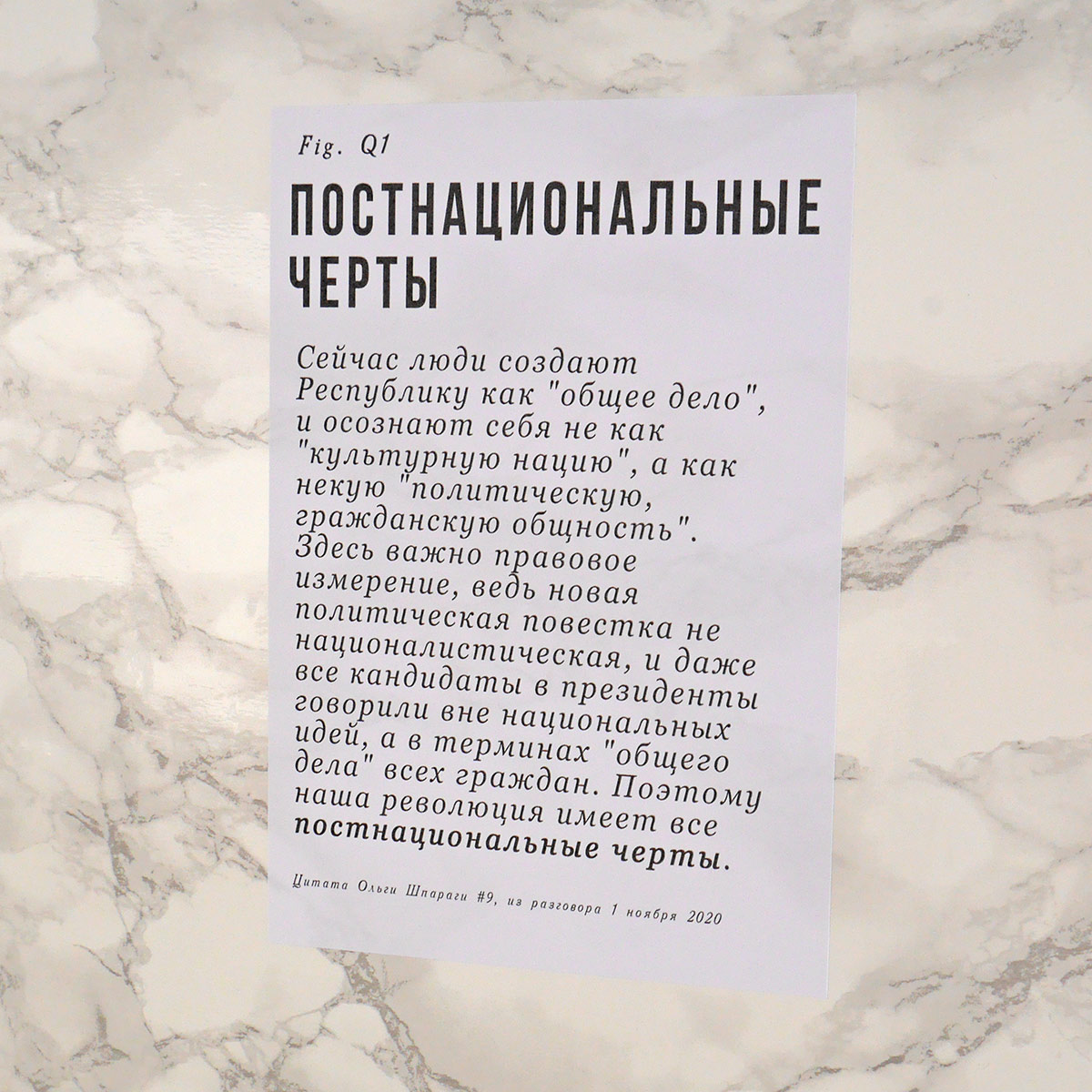
Quote by Olga Shparaga #9
People are now creating the Republic as a "common cause" and they recognise themselves not as a "cultural nation" but as a "political, civic community". The legal dimension is important here, because the new political agenda is not nationalistic, and even all presidential candidates spoke out of national ideas, but in terms of "common cause" for all citizens. This is why our revolution has all the post-national features.
From a conversation on the 1st of November 2020
Post-National Features
People are now creating the Republic as a "common cause" and they recognise themselves not as a "cultural nation" but as a "political, civic community". The legal dimension is important here, because the new political agenda is not nationalistic, and even all presidential candidates spoke out of national ideas, but in terms of "common cause" for all citizens. This is why our revolution has all the post-national features.
From a conversation on the 1st of November 2020
Цитата Ольги Шпараги #9
Сейчас люди создают Республику как "общее дело", и осознают себя не как "культурную нацию", а как некую "политическую, гражданскую общность". Здесь важно правовое измерение, ведь новая политическая повестка не националистическая, и даже все кандидаты в президенты говорили вне национальных идей, а в терминах "общего дела" всех граждан. Поэтому наша революция имеет все постнациональные черты.
Из разговора 1 ноября 2020
Постнациональные черты
Сейчас люди создают Республику как "общее дело", и осознают себя не как "культурную нацию", а как некую "политическую, гражданскую общность". Здесь важно правовое измерение, ведь новая политическая повестка не националистическая, и даже все кандидаты в президенты говорили вне национальных идей, а в терминах "общего дела" всех граждан. Поэтому наша революция имеет все постнациональные черты.
Из разговора 1 ноября 2020
Fig. R1
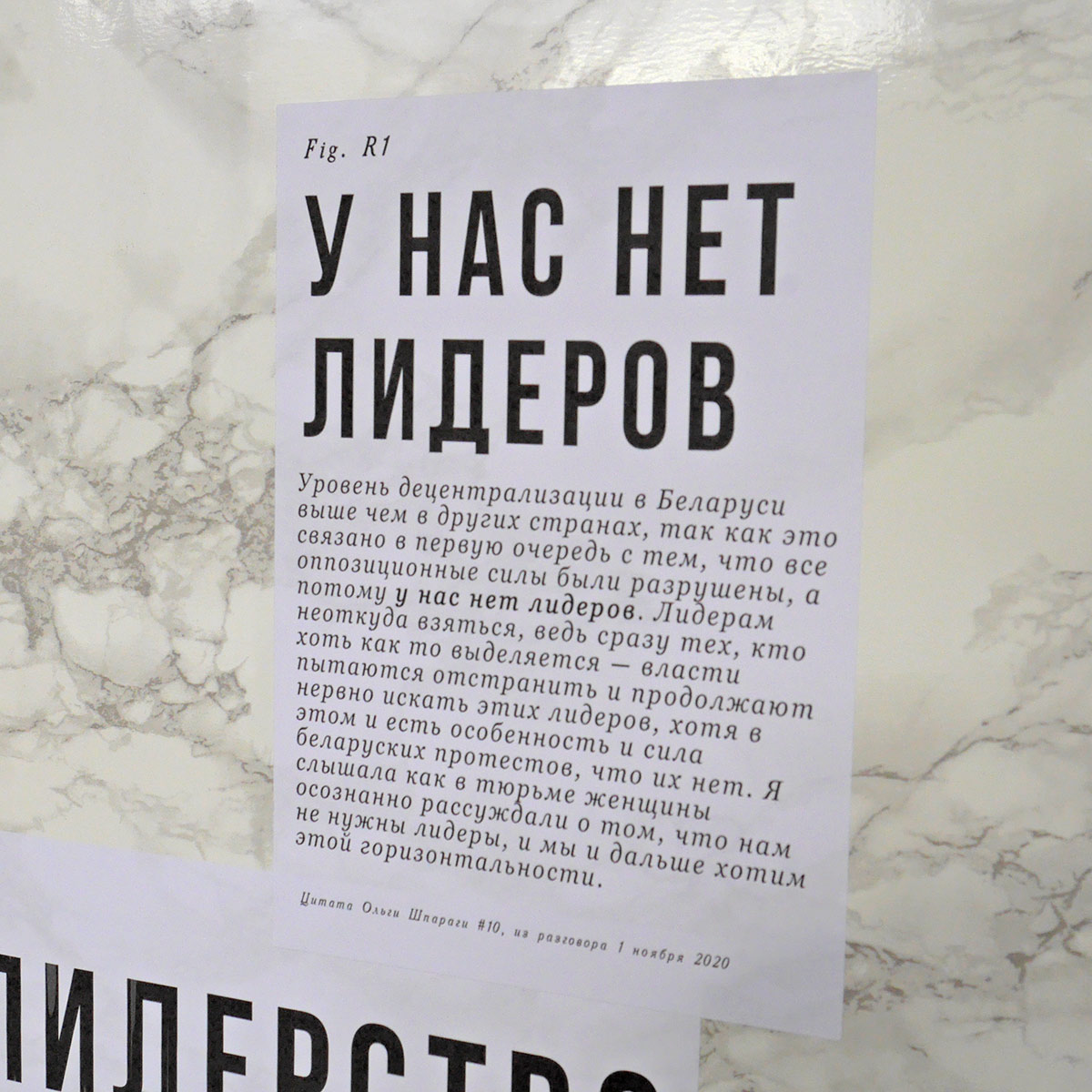
Quote by Olga Shparaga #10
The level of decentralization in Belarus is higher than in other countries, as it is primarily due to the fact that all opposition forces were destroyed, and therefore we have no leaders. Leaders have nowhere to appear from, because the authorities try to remove those who stand out at least somehow, and continue to look for these leaders nervously, although this is the peculiarity and strength of the Belarusian protests that they do not exist. I heard women in prison consciously reasoning that we do not need leaders, and we still want this horizontality.
From the conversation on the 1st of November 2020
We Have No Leaders
The level of decentralization in Belarus is higher than in other countries, as it is primarily due to the fact that all opposition forces were destroyed, and therefore we have no leaders. Leaders have nowhere to appear from, because the authorities try to remove those who stand out at least somehow, and continue to look for these leaders nervously, although this is the peculiarity and strength of the Belarusian protests that they do not exist. I heard women in prison consciously reasoning that we do not need leaders, and we still want this horizontality.
From the conversation on the 1st of November 2020
Цитата Ольги Шпараги #10
Уровень децентрализации в Беларуси выше чем в других странах, так как это связано в первую очередь с тем, что все оппозиционные силы были разрушены, а потому у нас нет лидеров. Лидерам неоткуда взяться, ведь сразу тех, кто хоть как то выделяется — власти пытаются отстранить и продолжают нервно искать этих лидеров, хотя в этом и есть особенность и сила беларуских протестов, что их нет. Я слышала как в тюрьме женщины осознанно рассуждали о том, что нам не нужны лидеры, и мы и дальше хотим этой горизонтальности.
Из разговора 1 ноября 2020
У нас нет лидеров
Уровень децентрализации в Беларуси выше чем в других странах, так как это связано в первую очередь с тем, что все оппозиционные силы были разрушены, а потому у нас нет лидеров. Лидерам неоткуда взяться, ведь сразу тех, кто хоть как то выделяется — власти пытаются отстранить и продолжают нервно искать этих лидеров, хотя в этом и есть особенность и сила беларуских протестов, что их нет. Я слышала как в тюрьме женщины осознанно рассуждали о том, что нам не нужны лидеры, и мы и дальше хотим этой горизонтальности.
Из разговора 1 ноября 2020
Fig. S1
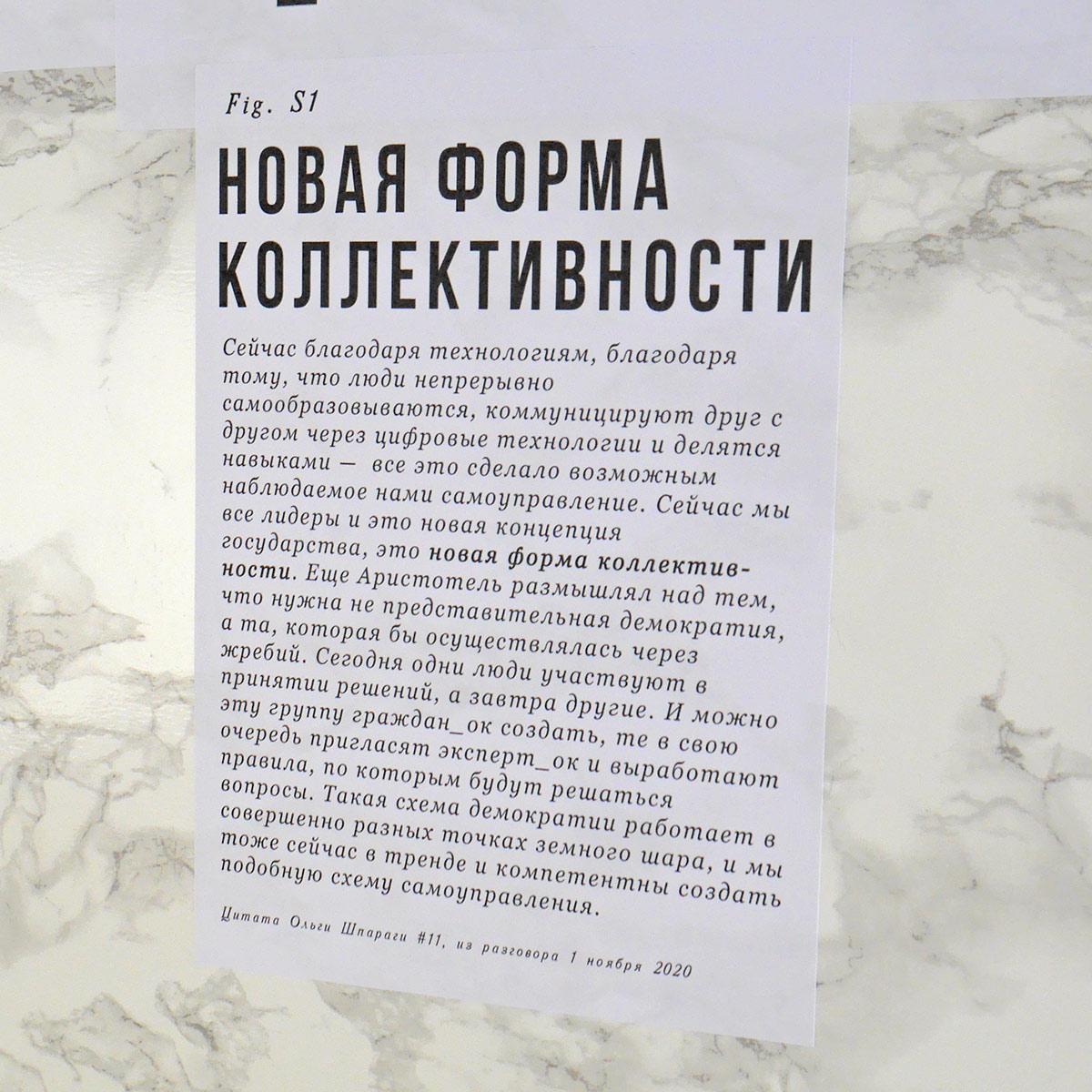
Quote by Olga Shparaga #11
Now, thanks to technology, thanks to the fact that people continuously self-educate, communicate with each other through digital technologies and share skills - all this has made possible the self-administration we see. Now we are all leaders and this is a new concept of the state, a new form of collectivity. Aristotle also pondered the need not for a representative democracy, but one that would be implemented through a draw. Today some people participate in decision-making, and tomorrow others. And it is possible to create this group of citizens, who, in their turn, will invite experts and work out the rules by which questions will be solved. Such a scheme of democracy works in completely different parts of the world, and we are also in a trend now and are competent to create such a scheme of self-governance.
From the conversation on the 1st of November 2020
A New Form of Collectivity
Now, thanks to technology, thanks to the fact that people continuously self-educate, communicate with each other through digital technologies and share skills - all this has made possible the self-administration we see. Now we are all leaders and this is a new concept of the state, a new form of collectivity. Aristotle also pondered the need not for a representative democracy, but one that would be implemented through a draw. Today some people participate in decision-making, and tomorrow others. And it is possible to create this group of citizens, who, in their turn, will invite experts and work out the rules by which questions will be solved. Such a scheme of democracy works in completely different parts of the world, and we are also in a trend now and are competent to create such a scheme of self-governance.
From the conversation on the 1st of November 2020
Цитата Ольги Шпараги #11
Сейчас благодаря технологиям, благодаря тому, что люди непрерывно самообразовываются, коммуницируют друг с другом через цифровые технологии и делятся навыками — все это сделало возможным наблюдаемое нами самоуправление. Сейчас мы все лидеры и это новая концепция государства, это новая форма коллективности. Еще Аристотель размышлял над тем, что нужна не представительная демократия, а та, которая бы осуществлялась через жребий. Сегодня одни люди участвуют в принятии решений, а завтра другие. И можно эту группу граждан_ок создать, те в свою очередь пригласят эксперт_ок и выработают правила, по которым будут решаться вопросы. Такая схема демократии работает в совершенно разных точках земного шара, и мы тоже сейчас в тренде и компетентны создать подобную схему самоуправления.
Из разговора 1 ноября 2020
Новая форма коллективности
Сейчас благодаря технологиям, благодаря тому, что люди непрерывно самообразовываются, коммуницируют друг с другом через цифровые технологии и делятся навыками — все это сделало возможным наблюдаемое нами самоуправление. Сейчас мы все лидеры и это новая концепция государства, это новая форма коллективности. Еще Аристотель размышлял над тем, что нужна не представительная демократия, а та, которая бы осуществлялась через жребий. Сегодня одни люди участвуют в принятии решений, а завтра другие. И можно эту группу граждан_ок создать, те в свою очередь пригласят эксперт_ок и выработают правила, по которым будут решаться вопросы. Такая схема демократии работает в совершенно разных точках земного шара, и мы тоже сейчас в тренде и компетентны создать подобную схему самоуправления.
Из разговора 1 ноября 2020
Fig. T1

Keyword # 1
Interaction / Blockchain Protest / Harmonious Development / Horizontal Mobility / Permanent Dialogue / Subsystems / Equality / Self-Governance / Social Horizontal
See:
Fig. I1: This is the anthem of horizontality
Fig. P1: Awakening of the common
Fig. U3: Opening up society
Fig. U4: Blockchain Protest
Fig. B5: White Ribbon
Fig. W5: There is no hierarchy in this resistance
Fig. L6: White-red-white and rainbow flags
Fig. Q7: Dialogue skills
Horizontal
Interaction / Blockchain Protest / Harmonious Development / Horizontal Mobility / Permanent Dialogue / Subsystems / Equality / Self-Governance / Social Horizontal
See:
Fig. I1: This is the anthem of horizontality
Fig. P1: Awakening of the common
Fig. U3: Opening up society
Fig. U4: Blockchain Protest
Fig. B5: White Ribbon
Fig. W5: There is no hierarchy in this resistance
Fig. L6: White-red-white and rainbow flags
Fig. Q7: Dialogue skills
Ключевое слово #1
Взаимодействие / Блокчейн протест / Гармоничное развитие / Горизонтальная мобильность / Перманентный диалог / Подсистемы / Равноправие / Самоуправление / Социальная горизонталь
Смотри:
Fig. I1: Это гимн горизонтальности
Fig. P1: Пробуждение общего
Fig. U3: Открыть общество
Fig. U4: Блокчейн протест
Fig. B5: Белая лента
Fig. W5: В этом сопротивлении отсутствует иерархия
Fig. L6: Бело-красно-белый и радужный флаги
Fig. Q7: Навыки диалога
Горизонталь
Взаимодействие / Блокчейн протест / Гармоничное развитие / Горизонтальная мобильность / Перманентный диалог / Подсистемы / Равноправие / Самоуправление / Социальная горизонталь
Смотри:
Fig. I1: Это гимн горизонтальности
Fig. P1: Пробуждение общего
Fig. U3: Открыть общество
Fig. U4: Блокчейн протест
Fig. B5: Белая лента
Fig. W5: В этом сопротивлении отсутствует иерархия
Fig. L6: Бело-красно-белый и радужный флаги
Fig. Q7: Навыки диалога
Fig. U1

Contributor # 2
Nadya Sayapina is an artist, author of projects, art tutor. Her artistic practices include performance, multimedia, installations, land art, painting, text. She explores mediation in art through the prism of performative practices and processualism. Nadya addresses the themes of corporeality, self-reflection, memory, and the feminist agenda. She participates in projects and residences in Belarus and abroad.
In July 2020, she organized the performance "Heritage", during which art workers attached to their backs the samples of works previously withdrawn from the Belgazprombank collection, and for several hours stood in front of QR codes placed on the walls where the withdrawn works used to be exhibited. The presented works were confiscated within the so-called "Belgazprombank case", which was previously headed by one of the potential presidential candidates Viktor Babariko. The collection is represented by a number of art works (more than 100), the core of the collection is the paintings by the Belarusian artists of the “Paris School”. The paintings by the world-famous artists like Marc Chagall and Chaïm Soutine became the first original works in Belarus. 35 exhibits from the collection are included in the State List of Historical and Cultural Heritage of the Republic of Belarus.
On the 7th of September Nadya Sayapina was arrested at her home, a search was made, and her computer and drivers were seized. On the 8thof September Nadya was sentenced to 15 days of administrative arrest for taking part in an action/ performance against violence, during which on the 15th of August artists stood near the Palace of Arts with the photographs of victims of violence that happened on August 9 — 12. Nadya was sentenced to 15 days of administrative arrest according to Part 1 of Article 23.34 of the Administrative Offences Code (participation in an unauthorized demonstration). The international art community reacted to this situation by signing an open letter, linking this arrest with the repression of the artists. The letter began: “We believe that the administrative arrest of the artist Nadya Sayapina, as well as other artists, is a persecution in Belarus for the exercise of their constitutional right to express civil and professional position".
Lives and works in Minsk.
Nadya Sayapina
Nadya Sayapina is an artist, author of projects, art tutor. Her artistic practices include performance, multimedia, installations, land art, painting, text. She explores mediation in art through the prism of performative practices and processualism. Nadya addresses the themes of corporeality, self-reflection, memory, and the feminist agenda. She participates in projects and residences in Belarus and abroad.
In July 2020, she organized the performance "Heritage", during which art workers attached to their backs the samples of works previously withdrawn from the Belgazprombank collection, and for several hours stood in front of QR codes placed on the walls where the withdrawn works used to be exhibited. The presented works were confiscated within the so-called "Belgazprombank case", which was previously headed by one of the potential presidential candidates Viktor Babariko. The collection is represented by a number of art works (more than 100), the core of the collection is the paintings by the Belarusian artists of the “Paris School”. The paintings by the world-famous artists like Marc Chagall and Chaïm Soutine became the first original works in Belarus. 35 exhibits from the collection are included in the State List of Historical and Cultural Heritage of the Republic of Belarus.
On the 7th of September Nadya Sayapina was arrested at her home, a search was made, and her computer and drivers were seized. On the 8thof September Nadya was sentenced to 15 days of administrative arrest for taking part in an action/ performance against violence, during which on the 15th of August artists stood near the Palace of Arts with the photographs of victims of violence that happened on August 9 — 12. Nadya was sentenced to 15 days of administrative arrest according to Part 1 of Article 23.34 of the Administrative Offences Code (participation in an unauthorized demonstration). The international art community reacted to this situation by signing an open letter, linking this arrest with the repression of the artists. The letter began: “We believe that the administrative arrest of the artist Nadya Sayapina, as well as other artists, is a persecution in Belarus for the exercise of their constitutional right to express civil and professional position".
Lives and works in Minsk.
Контрибьюторка #2
Надя Саяпина
Надя Саяпина – художница, авторка проектов, арт-тьюторка. Её художественные практики включают перформанс, мультимедиа, инсталляции, лэнд-арт, живопись, текст. Исследует медиацию в искусстве через призму перформативных практик и процессуальности. Обращается к темам телесности, саморефлексии, памяти, феминистской повестке. Участвует в проектах и резиденциях в Беларуси и за рубежом.
В июле 2020 года организовала перфоманс «Достояние», во время которого деятели культуры и искусства прикрепили к своим спинам репродукции работ, ранее изъятых из коллекции Белгазпромбанка, и на протяжении нескольких часов стояли напротив QR-кодов, размещенных на стенах на местах изъятых работ. Представленные произведения были конфискованы в рамках так называемого "дела Белгазпромбанка", который ранее возглавлял один из потенциальных кандидатов в президенты Виктор Бабарико. Коллекция представлена собранием произведений искусства (более 100 артефактов), ядро коллекции составляют произведения художников Парижской школы — уроженцев Беларуси. Живописные полотна всемирно известных художников Марка Шагала и Хаима Сутина стали первыми в Беларуси оригинальными произведениями. 35 экспонатов собрания включены в Государственный список историко-культурных ценностей Республики Беларусь.
7 сентября художница была задержана у себя дома, также был проведён обыск и изъята компьютерная техника и носители информации. 8 сентября за участие в акции/перформансе против насилия, в рамках которого 15 августа художни_цы стояли возле Дворца искусств с фотографиями потерпевших во время протестов и задержаний 9 — 12 августа, Наде присудили 15 суток административного ареста согласно ч. 1 арт. 23.34 Кодекса об административных правонарушениях (участие в несанкционированном массовом мероприятии). Международное художественное сообщество отреагировало на данную ситуацию подписанием открытого письма, связывая данный арест с начавшимися репрессиями творческой среды: "Мы считаем, что административный арест художницы Надежды Саяпиной, а также других работников и работниц культуры, является преследованием за реализацию своего конституционного права на выражение гражданской и профессиональной позиции в Беларуси".
Живет и работает в Минске.
Надя Саяпина
Надя Саяпина – художница, авторка проектов, арт-тьюторка. Её художественные практики включают перформанс, мультимедиа, инсталляции, лэнд-арт, живопись, текст. Исследует медиацию в искусстве через призму перформативных практик и процессуальности. Обращается к темам телесности, саморефлексии, памяти, феминистской повестке. Участвует в проектах и резиденциях в Беларуси и за рубежом.
В июле 2020 года организовала перфоманс «Достояние», во время которого деятели культуры и искусства прикрепили к своим спинам репродукции работ, ранее изъятых из коллекции Белгазпромбанка, и на протяжении нескольких часов стояли напротив QR-кодов, размещенных на стенах на местах изъятых работ. Представленные произведения были конфискованы в рамках так называемого "дела Белгазпромбанка", который ранее возглавлял один из потенциальных кандидатов в президенты Виктор Бабарико. Коллекция представлена собранием произведений искусства (более 100 артефактов), ядро коллекции составляют произведения художников Парижской школы — уроженцев Беларуси. Живописные полотна всемирно известных художников Марка Шагала и Хаима Сутина стали первыми в Беларуси оригинальными произведениями. 35 экспонатов собрания включены в Государственный список историко-культурных ценностей Республики Беларусь.
7 сентября художница была задержана у себя дома, также был проведён обыск и изъята компьютерная техника и носители информации. 8 сентября за участие в акции/перформансе против насилия, в рамках которого 15 августа художни_цы стояли возле Дворца искусств с фотографиями потерпевших во время протестов и задержаний 9 — 12 августа, Наде присудили 15 суток административного ареста согласно ч. 1 арт. 23.34 Кодекса об административных правонарушениях (участие в несанкционированном массовом мероприятии). Международное художественное сообщество отреагировало на данную ситуацию подписанием открытого письма, связывая данный арест с начавшимися репрессиями творческой среды: "Мы считаем, что административный арест художницы Надежды Саяпиной, а также других работников и работниц культуры, является преследованием за реализацию своего конституционного права на выражение гражданской и профессиональной позиции в Беларуси".
Живет и работает в Минске.
Fig. V1

Quote by Nadya Sayapina # 1
Not only in Belarus, but also outside of it, people emphasize that the revolution in Belarus has a woman's face. As I follow what is happening, I see that the women are at the forefront of resistance, and at every crucial point I see female figures. I recently wrote a text about this where I describe a storyline between the arrest of “Eve” and “eve”-olution, the cooperation of campaign offices led by three women, and the women's protest marches. Our activist group is also heavily represented by women. And many of us have been arrested. Suffering Eves.
From a conversation on the 2nd of November 2020
Suffering Eves
Not only in Belarus, but also outside of it, people emphasize that the revolution in Belarus has a woman's face. As I follow what is happening, I see that the women are at the forefront of resistance, and at every crucial point I see female figures. I recently wrote a text about this where I describe a storyline between the arrest of “Eve” and “eve”-olution, the cooperation of campaign offices led by three women, and the women's protest marches. Our activist group is also heavily represented by women. And many of us have been arrested. Suffering Eves.
From a conversation on the 2nd of November 2020
Цитата Нади Саяпиной #1
Страдающие Евы
Не только в Беларуси, но и наблюдатели извне подчеркивают, что у революции в Беларуси женское лицо. Наблюдая за тем, что происходит, я обнаруживаю, что женщины действительно в авангарде сопротивления, и на каждом решительном этапе я вижу женские фигуры. Я как раз об этом написала текст, в котором описывается эта линия от ареста “Евы” и евалюции, к объединению штабов во главе с триадой женщин и к женским маршам протеста. Наш активистский сектор также в большей степени представлен женщинами. И очень многих из нас арестовали. Страдающие Евы.
Из разговора 2 ноября 2020
Страдающие Евы
Не только в Беларуси, но и наблюдатели извне подчеркивают, что у революции в Беларуси женское лицо. Наблюдая за тем, что происходит, я обнаруживаю, что женщины действительно в авангарде сопротивления, и на каждом решительном этапе я вижу женские фигуры. Я как раз об этом написала текст, в котором описывается эта линия от ареста “Евы” и евалюции, к объединению штабов во главе с триадой женщин и к женским маршам протеста. Наш активистский сектор также в большей степени представлен женщинами. И очень многих из нас арестовали. Страдающие Евы.
Из разговора 2 ноября 2020
Fig. W1
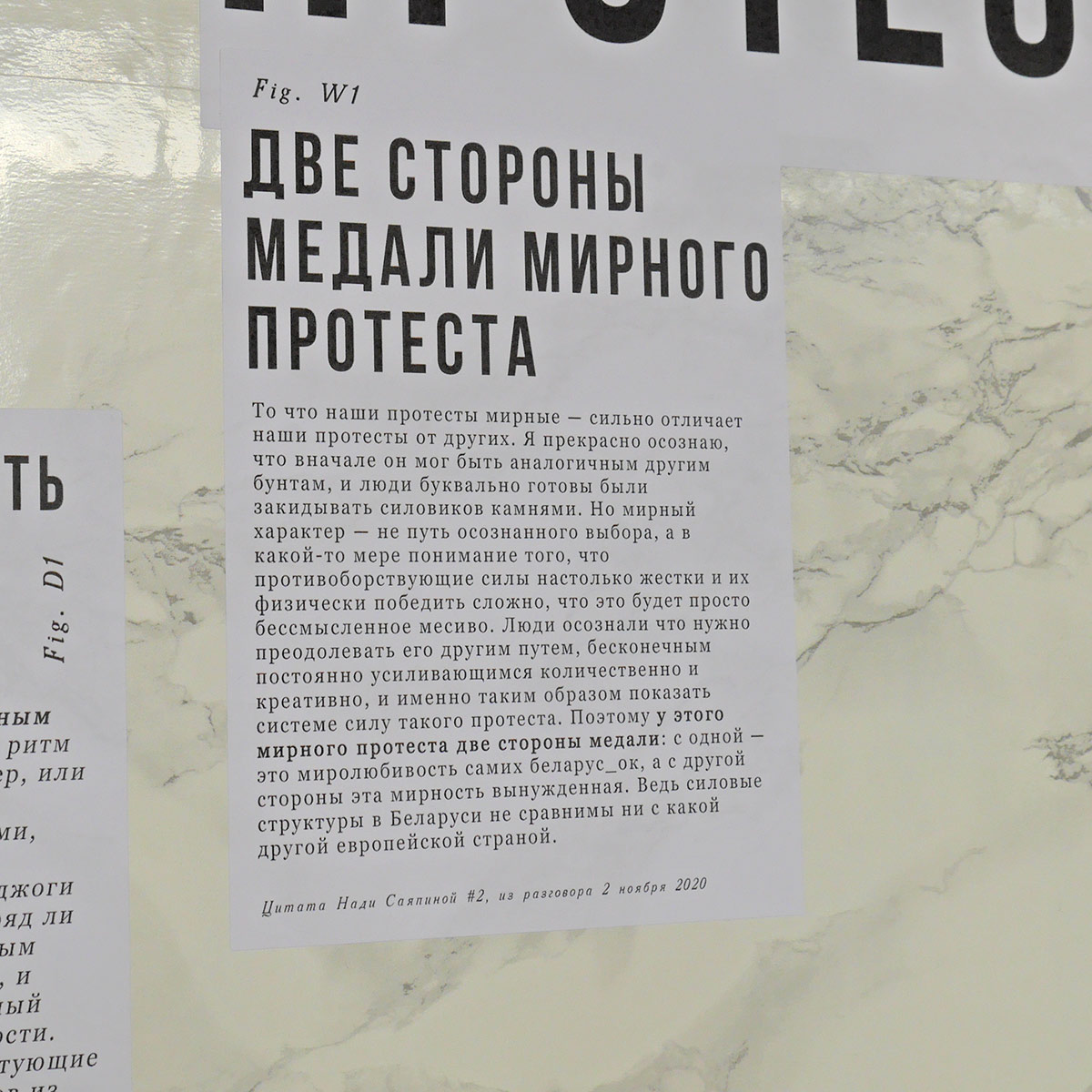
Quote by Nadya Sayapina # 2
The fact that our protests are peaceful makes our them very different from others. I am well aware that at first it could have been similar to other riots, and people were literally ready to throw stones at the riot police. But it was not a deliberate choice to have a peaceful protest, it happened rather because of understanding that the opposing forces are so violent, and it is difficult to defeat them physically that it will be just a useless mess. People realized that they need to defeat it in a different way – endlessly and continuously increasing the protest also in quantitative and creative ways, and in this was the way to show the system the power of this protest. Therefore, this peaceful protest has two sides to the coin: on the one hand, it is the peacefulness of the Belarusians themselves, and on the other hand, people had to act peacefully. After all, the structure of the military forces in Belarus cannot be compared with the ones in any other European country.
From a conversation on the 2nd of November 2020
This Peaceful Protest Has Two Sides to the Coin
The fact that our protests are peaceful makes our them very different from others. I am well aware that at first it could have been similar to other riots, and people were literally ready to throw stones at the riot police. But it was not a deliberate choice to have a peaceful protest, it happened rather because of understanding that the opposing forces are so violent, and it is difficult to defeat them physically that it will be just a useless mess. People realized that they need to defeat it in a different way – endlessly and continuously increasing the protest also in quantitative and creative ways, and in this was the way to show the system the power of this protest. Therefore, this peaceful protest has two sides to the coin: on the one hand, it is the peacefulness of the Belarusians themselves, and on the other hand, people had to act peacefully. After all, the structure of the military forces in Belarus cannot be compared with the ones in any other European country.
From a conversation on the 2nd of November 2020
Цитата Нади Саяпиной #2
Две стороны медали мирного протеста
То что наши протесты мирные – сильно отличает наши протесты от других. Я прекрасно осознаю, что вначале он мог быть аналогичным другим бунтам, и люди буквально готовы были закидывать силовиков камнями. Но мирный характер – не путь осознанного выбора, а в какой-то мере понимание того, что противоборствующие силы настолько жестки и их физически победить сложно, что это будет просто бессмысленное месиво. Люди осознали что нужно преодолевать его другим путем, бесконечным постоянно усиливающимся количественно и креативно, и именно таким образом показать системе силу такого протеста. Поэтому у этого мирного протеста две стороны медали: с одной – это миролюбивость самих беларус_ок, а с другой стороны эта мирность вынужденная. Ведь силовые структуры в Беларуси не сравнимы ни с какой другой европейской страной.
Из разговора 2 ноября 2020
Две стороны медали мирного протеста
То что наши протесты мирные – сильно отличает наши протесты от других. Я прекрасно осознаю, что вначале он мог быть аналогичным другим бунтам, и люди буквально готовы были закидывать силовиков камнями. Но мирный характер – не путь осознанного выбора, а в какой-то мере понимание того, что противоборствующие силы настолько жестки и их физически победить сложно, что это будет просто бессмысленное месиво. Люди осознали что нужно преодолевать его другим путем, бесконечным постоянно усиливающимся количественно и креативно, и именно таким образом показать системе силу такого протеста. Поэтому у этого мирного протеста две стороны медали: с одной – это миролюбивость самих беларус_ок, а с другой стороны эта мирность вынужденная. Ведь силовые структуры в Беларуси не сравнимы ни с какой другой европейской страной.
Из разговора 2 ноября 2020
Fig. X1
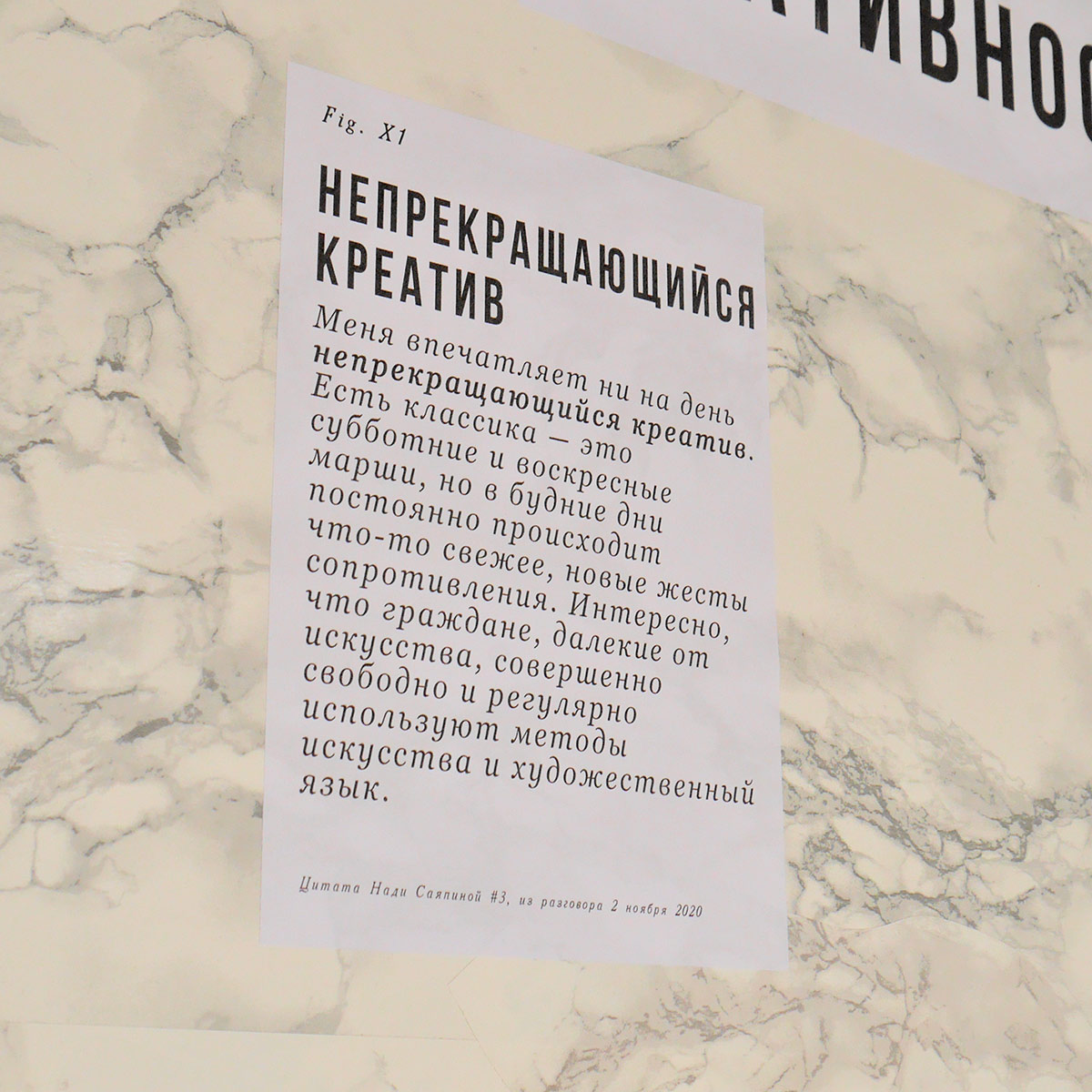
Quote by Nadya Sayapina # 3
Endless Creativity
I am impressed by the continuous creativity. Thea Saturday and Sunday marches became classics, but on weekdays something new and creative is constantly happening, new gestures of resistance. Interestingly, initiatives from citizens who used to be far from art use art methods and artistic language quite freely and regularly.
From a conversation on the 2nd of November 2020
Endless Creativity
I am impressed by the continuous creativity. Thea Saturday and Sunday marches became classics, but on weekdays something new and creative is constantly happening, new gestures of resistance. Interestingly, initiatives from citizens who used to be far from art use art methods and artistic language quite freely and regularly.
From a conversation on the 2nd of November 2020
Цитата Нади Саяпиной #3
Меня впечатляет ни на день непрекращающийся креатив. Есть классика – это субботние и воскресные марши, но в будние дни постоянно происходит что-то свежее, новые жесты сопротивления. Интересно, что граждане, далекие от искусства, совершенно свободно и регулярно используют методы искусства и художественный язык.
Из разговора 2 ноября 2020
Непрекращающийся креатив
Меня впечатляет ни на день непрекращающийся креатив. Есть классика – это субботние и воскресные марши, но в будние дни постоянно происходит что-то свежее, новые жесты сопротивления. Интересно, что граждане, далекие от искусства, совершенно свободно и регулярно используют методы искусства и художественный язык.
Из разговора 2 ноября 2020
Fig. Y1
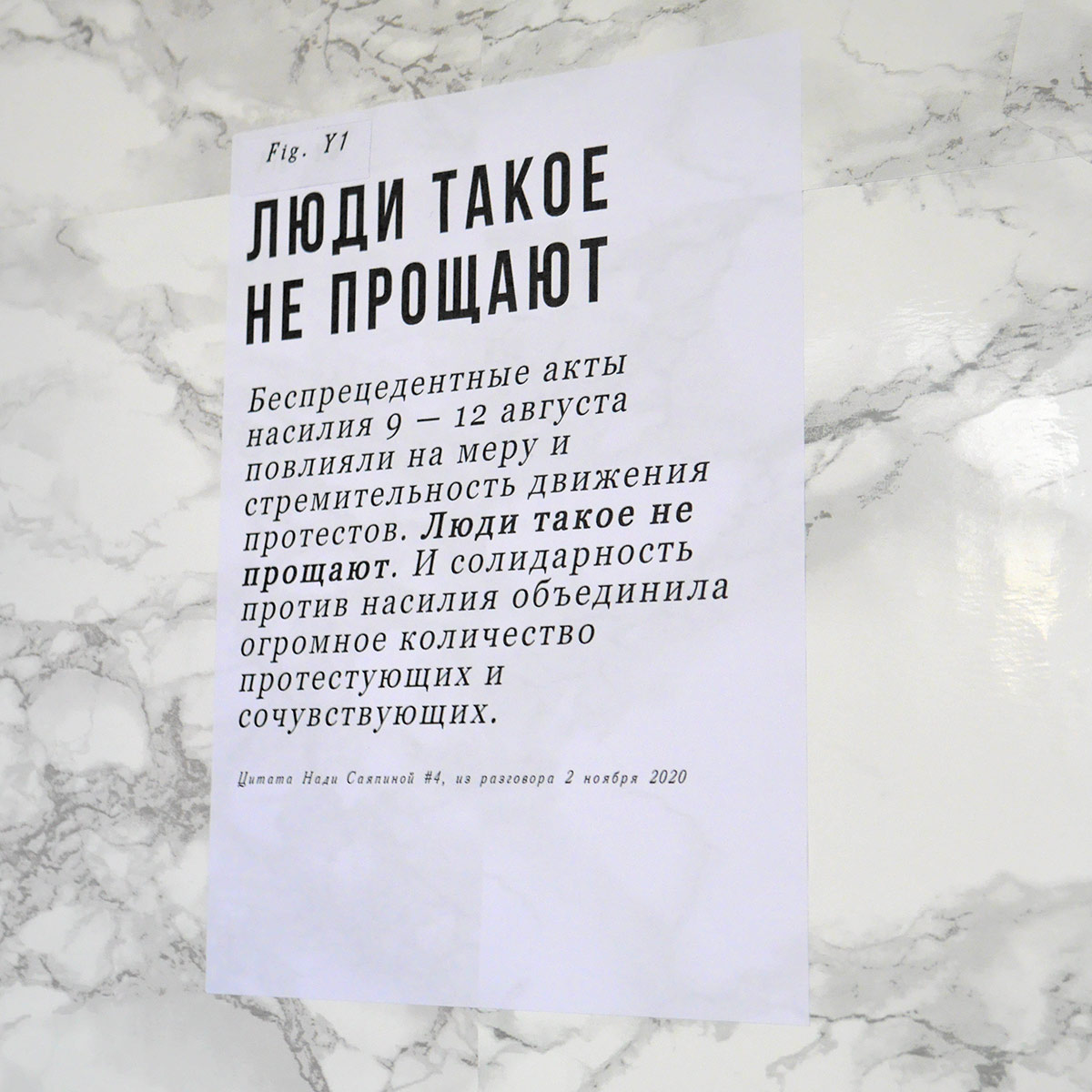
Quote by Nadya Sayapina # 4
The unprecedented acts of violence between the 9th and the 12th of August impacted the strength and velocity of the protest movement. People don't forgive that. And solidarity against violence has united a huge number of protesters and supporters.
From a conversation on the 2nd of November 2020
People Won't Forgive
The unprecedented acts of violence between the 9th and the 12th of August impacted the strength and velocity of the protest movement. People don't forgive that. And solidarity against violence has united a huge number of protesters and supporters.
From a conversation on the 2nd of November 2020
Цитата Нади Саяпиной #4
Люди такое не прощают
Беспрецедентные акты насилия 9 – 12 августа повлияли на меру и стремительность движения протестов. Люди такое не прощают. И солидарность против насилия объединила огромное количество протестующих и сочувствующих.
Из разговора 2 ноября 2020
Люди такое не прощают
Беспрецедентные акты насилия 9 – 12 августа повлияли на меру и стремительность движения протестов. Люди такое не прощают. И солидарность против насилия объединила огромное количество протестующих и сочувствующих.
Из разговора 2 ноября 2020
Fig. Z1
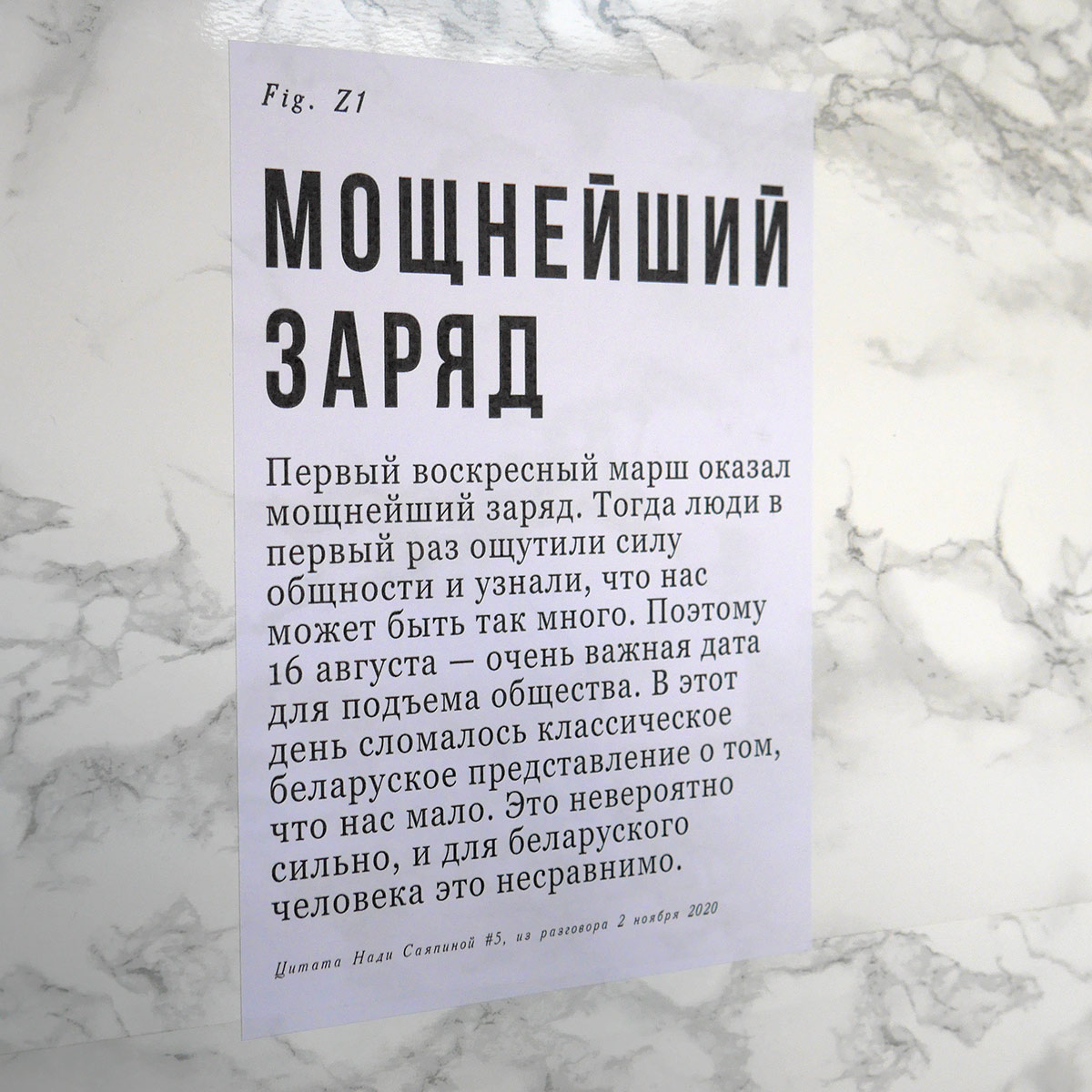
Quote by Nadya Sayapina # 5
Solidarity Energy Boost
The first Sunday march has charged people. Back then for the first time, people realized the power of a community and learned that there are so many of us, thinking alike. That’s why the 16th of August is a very important date for the rise of society. On that day, the well-believed Belarusian idea that there are not enough of us has broken down. This was incredibly strong, and for a Belarusian person nothing can compare with it.
From a conversation on the 2nd of November 2020
Solidarity Energy Boost
The first Sunday march has charged people. Back then for the first time, people realized the power of a community and learned that there are so many of us, thinking alike. That’s why the 16th of August is a very important date for the rise of society. On that day, the well-believed Belarusian idea that there are not enough of us has broken down. This was incredibly strong, and for a Belarusian person nothing can compare with it.
From a conversation on the 2nd of November 2020
Цитата Нади Саяпиной #5
Первый воскресный марш оказал мощнейший заряд. Тогда люди в первый раз ощутили силу общности и узнали, что нас может быть так много. Поэтому 16 августа – очень важная дата для подъема общества. В этот день сломалось классическое беларуское представление о том, что нас мало. Это невероятно сильно, и для беларуского человека это несравнимо.
Из разговора 2 ноября 2020
Мощнейший заряд
Первый воскресный марш оказал мощнейший заряд. Тогда люди в первый раз ощутили силу общности и узнали, что нас может быть так много. Поэтому 16 августа – очень важная дата для подъема общества. В этот день сломалось классическое беларуское представление о том, что нас мало. Это невероятно сильно, и для беларуского человека это несравнимо.
Из разговора 2 ноября 2020
